
Here are more photos I took on my first visit to the Birmingham Buddhist Vihara on 17/09/22.
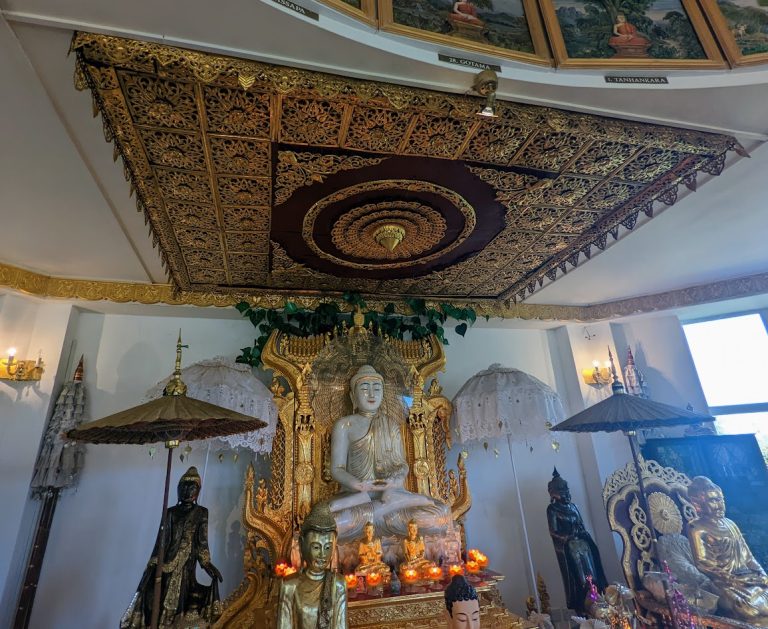
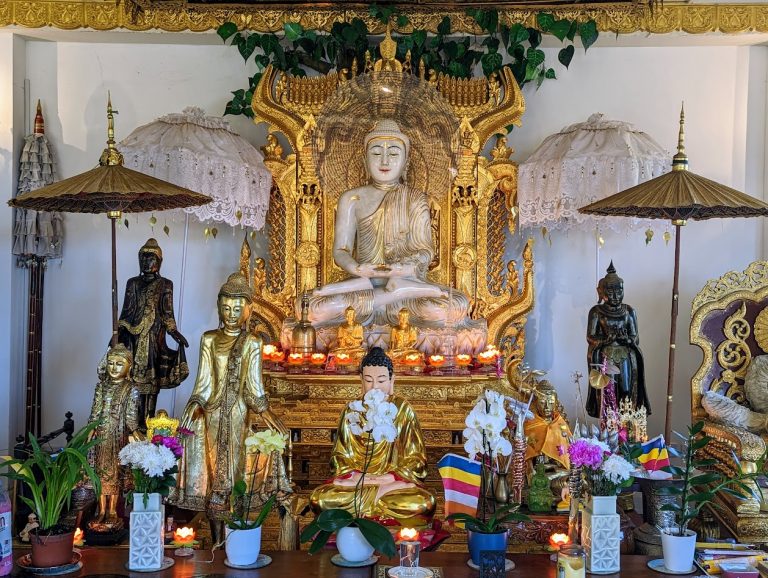

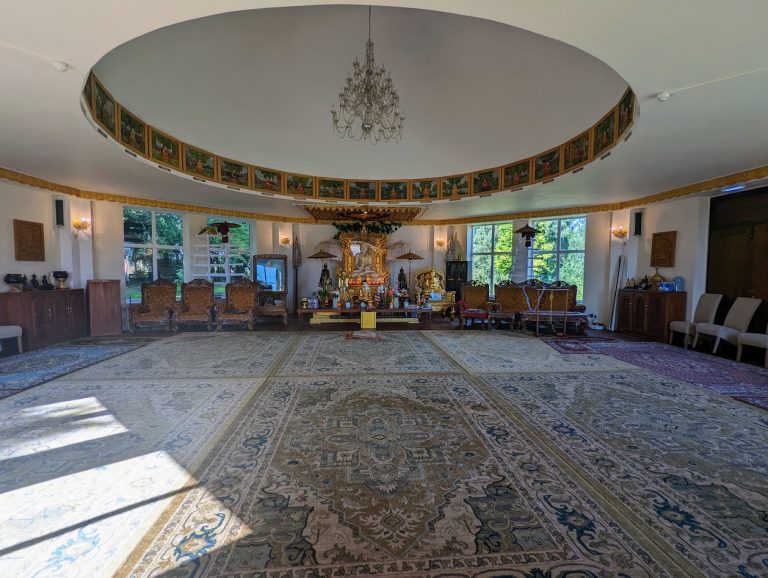
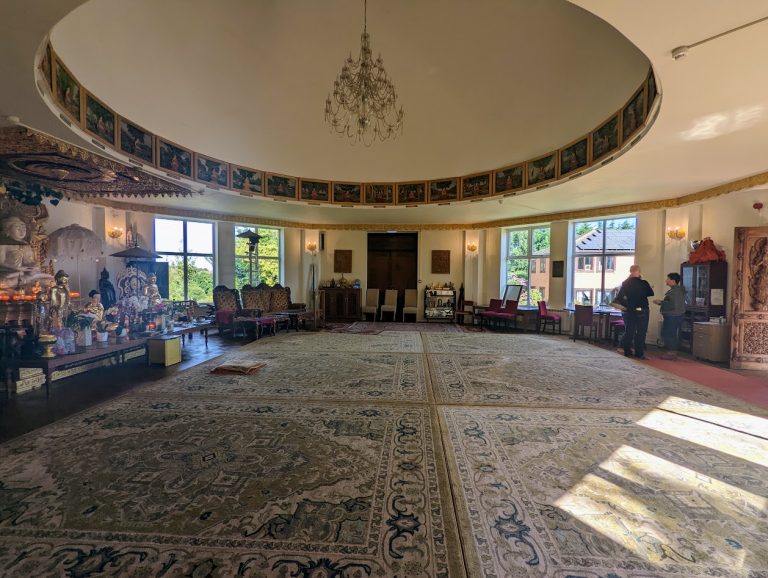
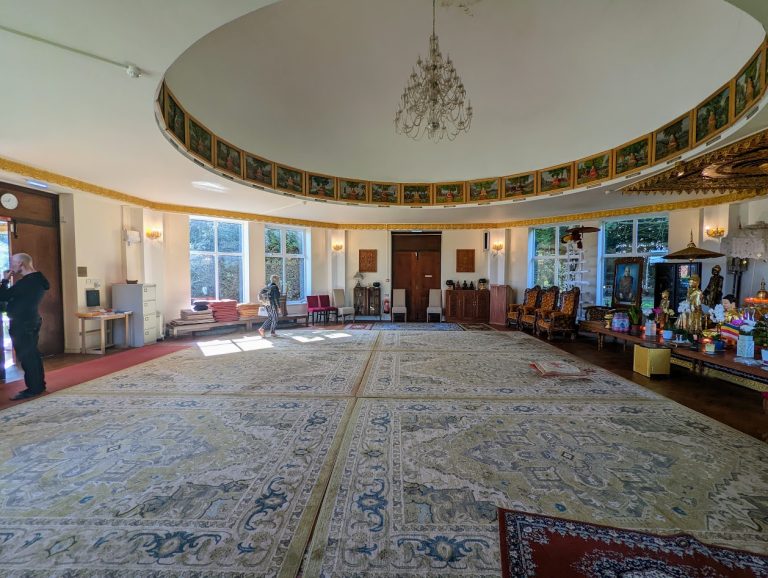
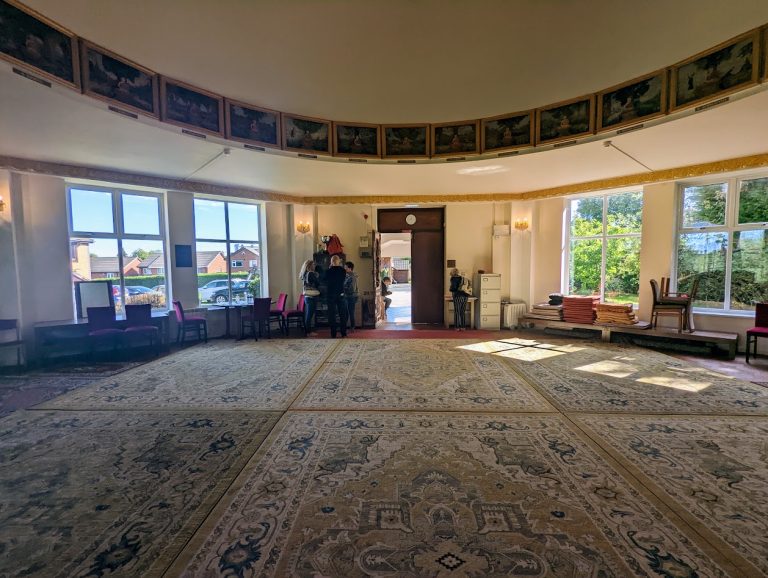
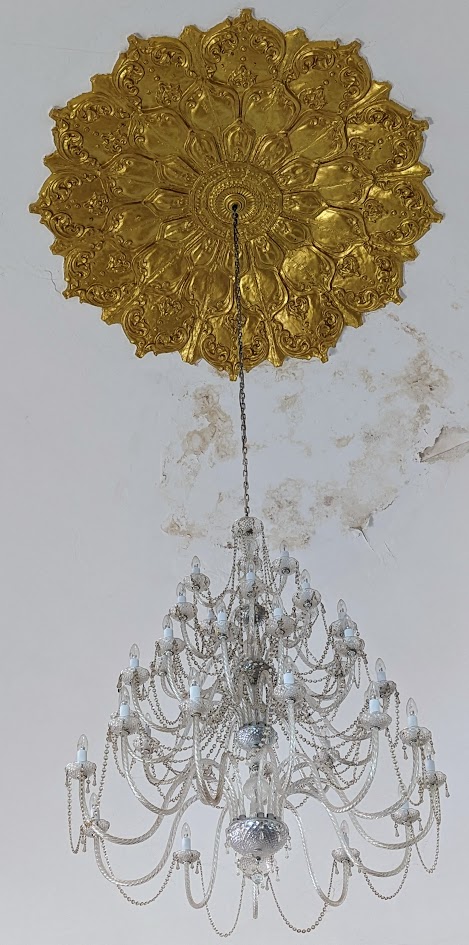

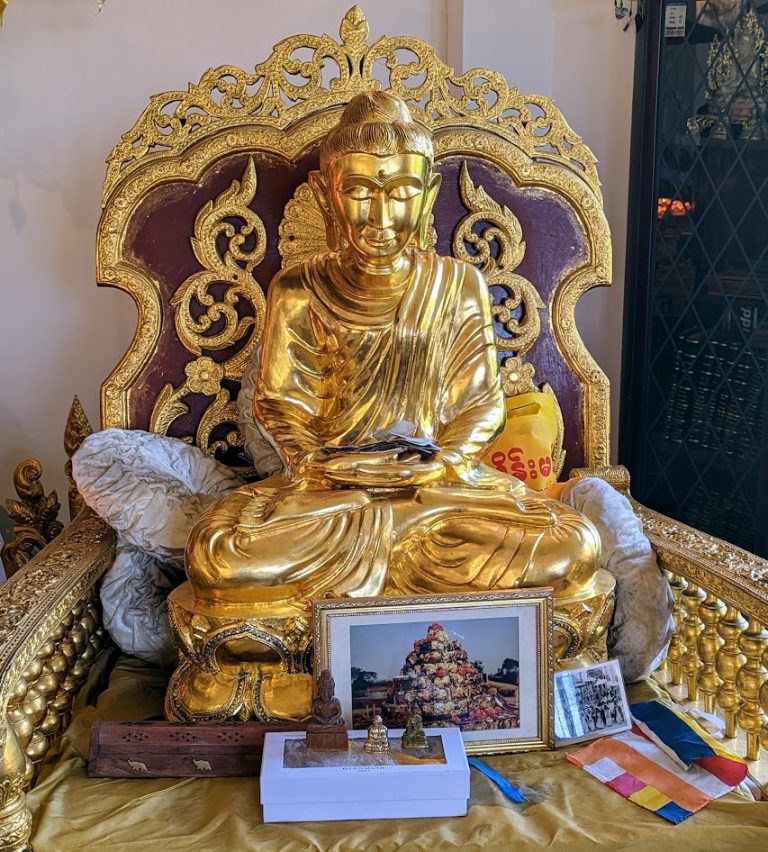
Blog Posts
Links
Welcome To My World

Here are more photos I took on my first visit to the Birmingham Buddhist Vihara on 17/09/22.










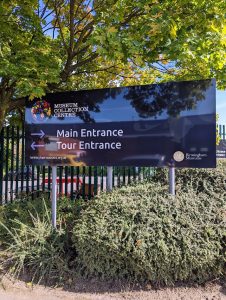
Here are more photos I took on my first visit to the Museum Collection Centre on 17/09/22.
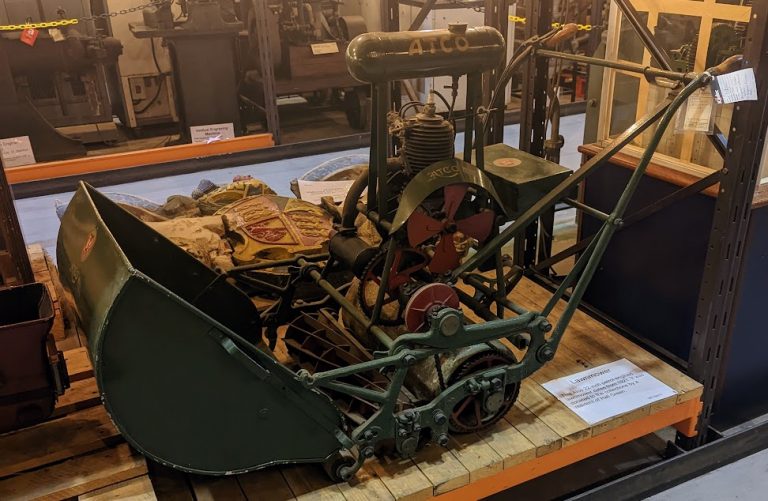
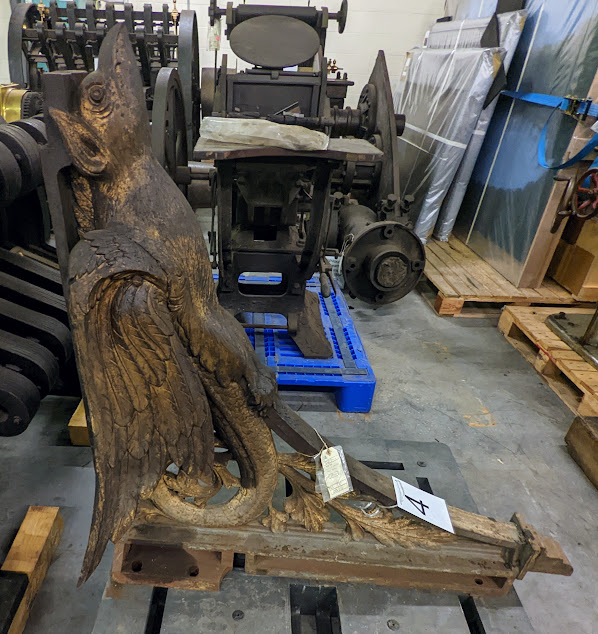
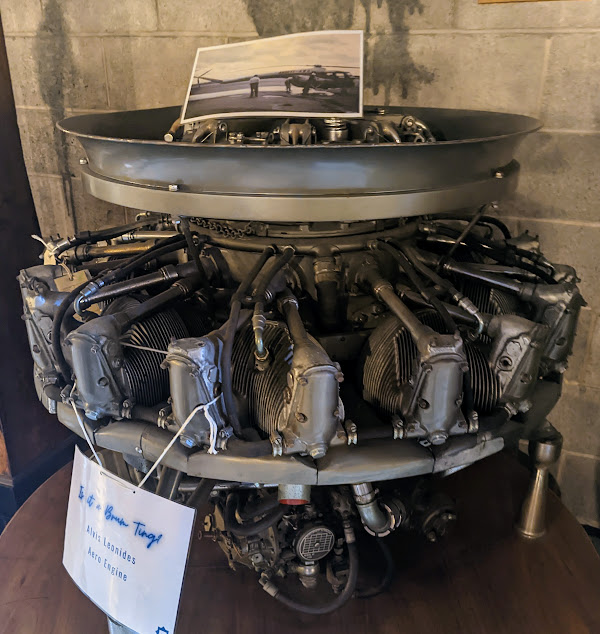
This is the Leonides engine made by Alvis Car and Engineering Company Limited of Coventry. It was fitted to the Bristol 171 Sycamore, the first post-war British commercial helicopter. It was also used by the military until production ended in 1959.
Read about the Alvis Leonides here.
Read about Alvis Car and Engineering Company Limited here.
Read about the Bristol 171 Sycamore here.
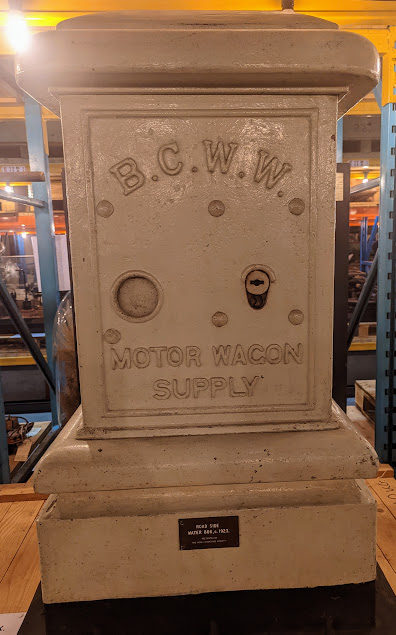
Difficulties in finding enough water in the 1920’s to refill the boilers in Steam Vehicles led to many authorities providing standpipes which needed a key for access. This one came from Birkenhead.
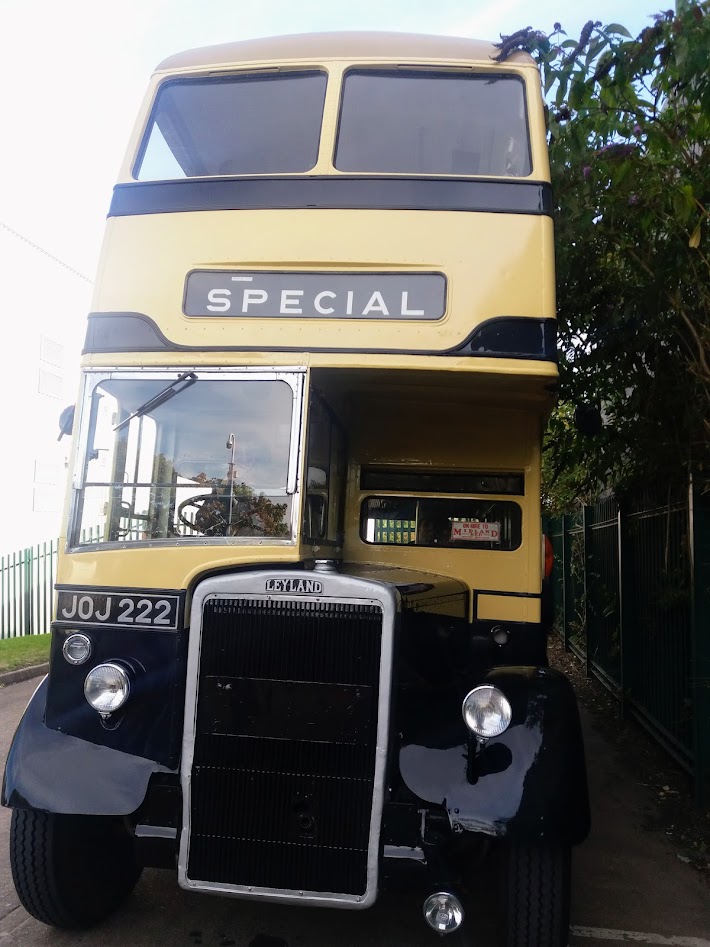
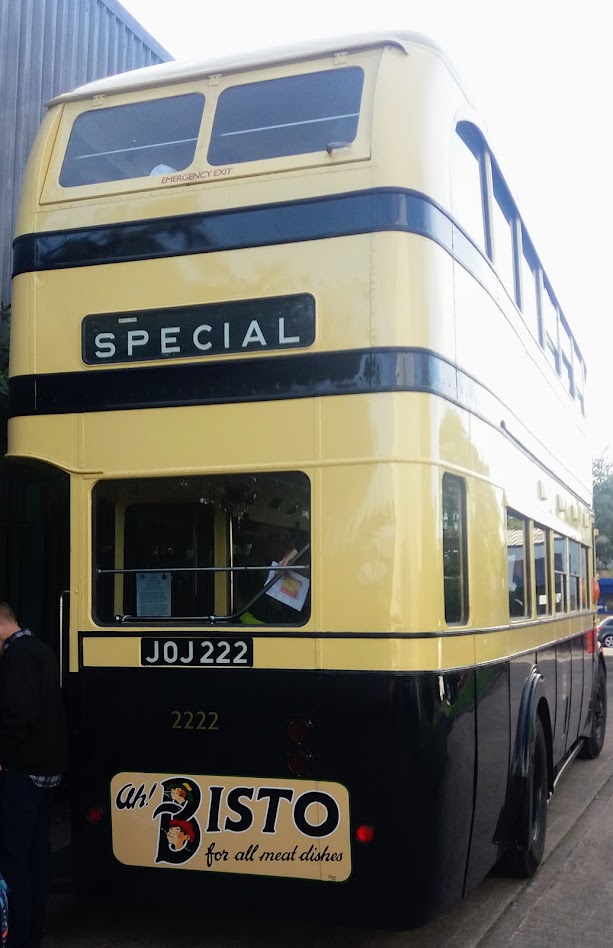
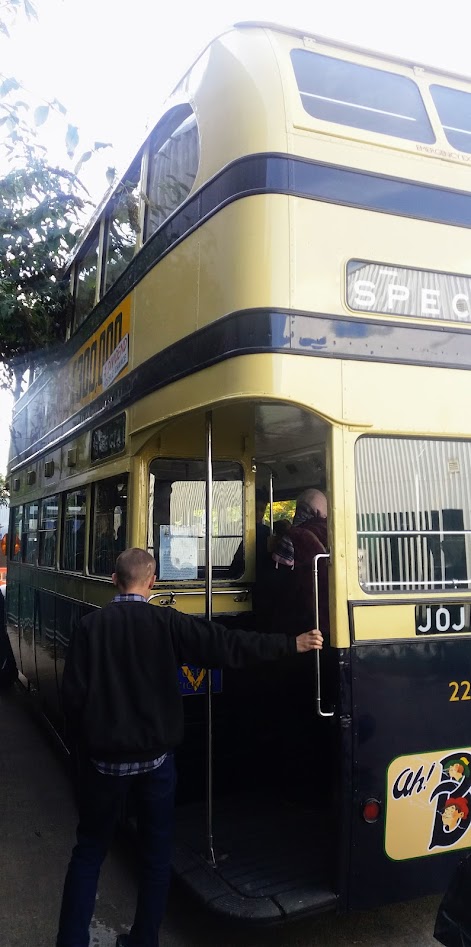
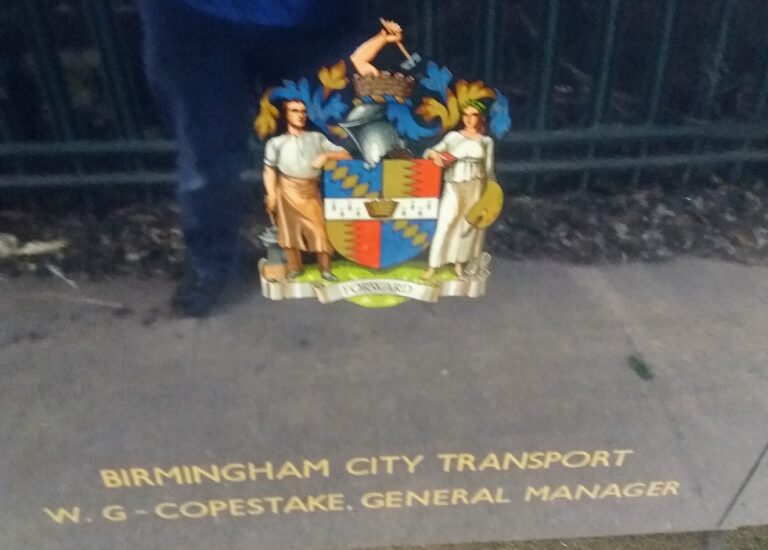
This PD2 is the only survivor of a batch of 50 Leyland Titan Buses with bodies by the London coachbuilder Park Royal. They were supplied to Birmingham City Transport between 1949 and 1952 and consistently associated with the Roseberry Street garage. The batch was unusual in having a number of features not generally associated with BCT design including a different staircase layout and window style.
The bus was one of the few that ended their working lives at the Quinton garage where it was withdrawn from service in 1969 and rescued from the scrap yard by Bob Shaw. The restoration was prolonged but, after a change of ownership to Nigel Stribley, mechanical work started in earnest, first at the Aldridge Transport Museum (where it is now) then elsewhere when the body restoration was also carried out. It took 47 years before it finally took to the road again. It was placed back at the Museum in 2017 where work is continuing, particularly on the interior.
Although not part of the Museum Collection Centre, this bus was there on the day I visited and its photos and information is worth sharing.
Read about the Leyland Titan here.
Read about Leyland Motors here.
Local History: The Museum Collection Centre.
The Museum Collection: Photos – Page 1.
The Museum Collection: Photos – Page 2.
The Museum Collection: Photos – Page 3.
The Museum Collection: Photos – Page 4.
The Museum Collection: Photos – Page 5.
The Museum Collection: Photos – Page 6.
The Museum Collection: Photos – Page 7.
All the above images are copyright of Frank Parker.
Museum Collection Centre on Facebook.
Museum Collection Centre on Twitter.
Birmingham Museums Collection – Find out more about Birmingham’s collections including art and design, human history, natural science and science and industry categories. Each category contains sub-categories full of useful information and great photos.
Birmingham Museums Trust’s Digital Asset Resource – Official website. There is no registration or log-in required to use this website for out-of-copyright collection images Download free Public Domain image files up to 3mb in size with free Creative Commons licenses. You are entitled to unlimited downloads. Also download free Audio Files complete with a license. These can be downloaded for non-commercial use only and attribution is required.
BirminghamMAG – Official YouTube channel. Birmingham Museums and Art Gallery provide world-class museums at the cultural heart of Birmingham.
Birmingham Museums – Official website.
Thinktank: Birmingham Science Museum – Official website.
Birmingham Museum And Art Gallery – Official website.
Aston Hall – Official website.
Blakesley Hall – Official website.
Museum Of The Jewellery Quarter – Official website.
Sarehole Mill – Official website.
Soho House – Official website.
Weoly Castle – Official website.

Here are more photos I took on my first visit to the Museum Collection Centre on 17/09/22.
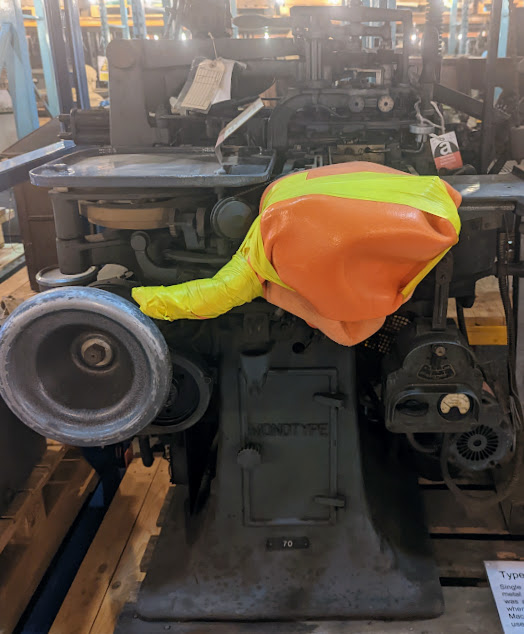
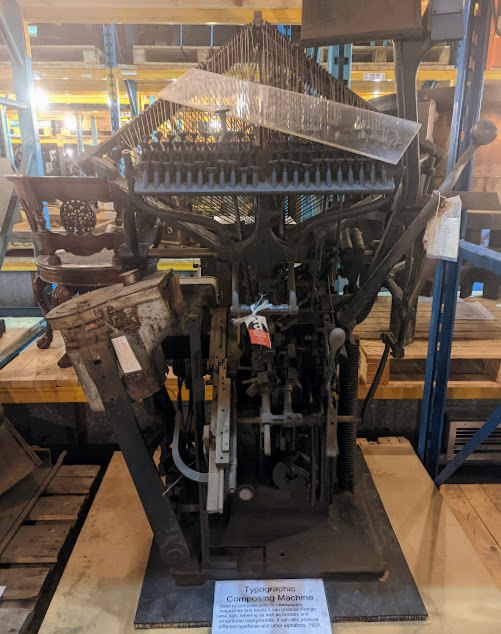
This machine is from 1925 and was used to compose print for newspapers, magazines and books it can produce Roman and Italic lettering as well as borders and ornamental backgrounds. It can also produce different typefaces and other alphabets.
Read about the Leyland Titan here.
Read about Typesetting here.
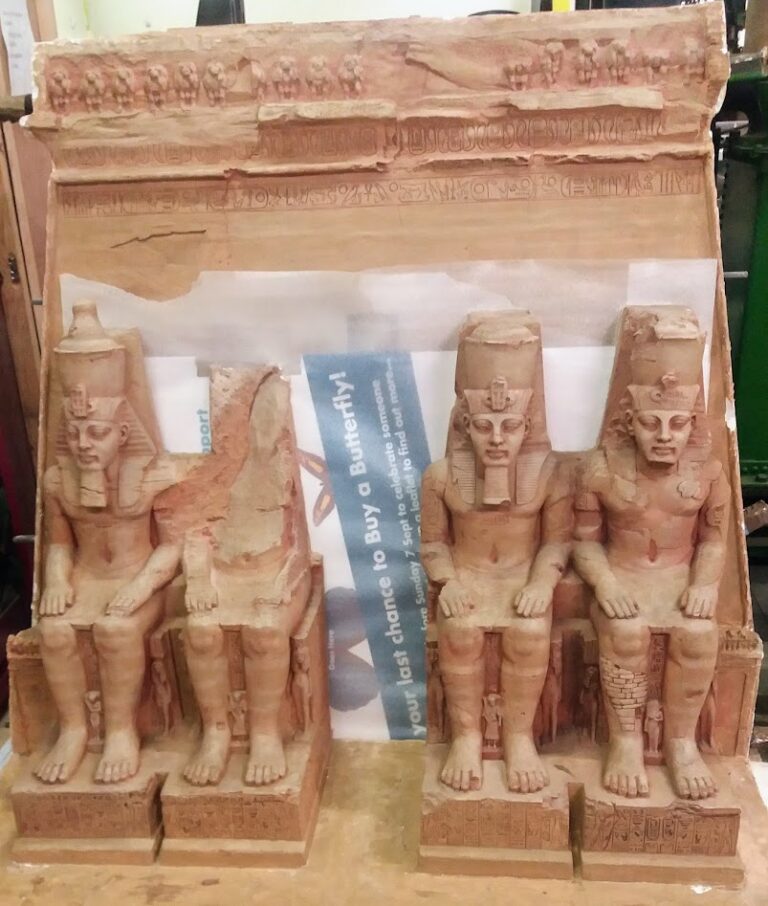
This was another favourite of mine visiting museums back in the day. This was in the Birmingham Museum and Art gallery.

This cash register was made by the National Cash Register Company of Dayton, Ohio. This one was used in a corn and seed merchant’s shop in Hitchin until 1971.
Read about the National Cash Register here.
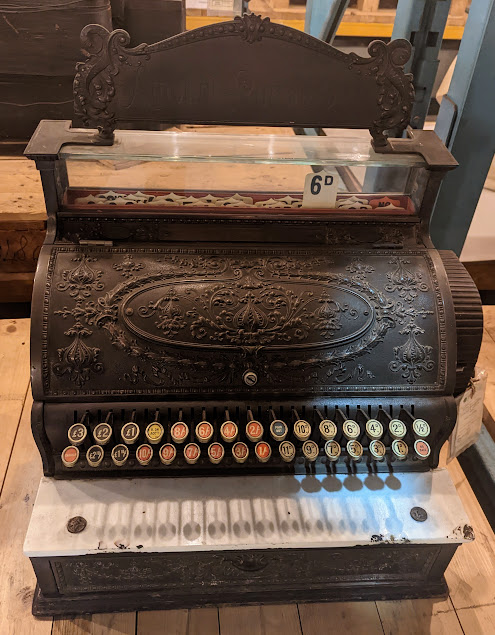
This cash register was made by the National Cash Register Company of Dayton, Ohio.
Read about the National Cash Register here.
Chinese Chair And Cushion
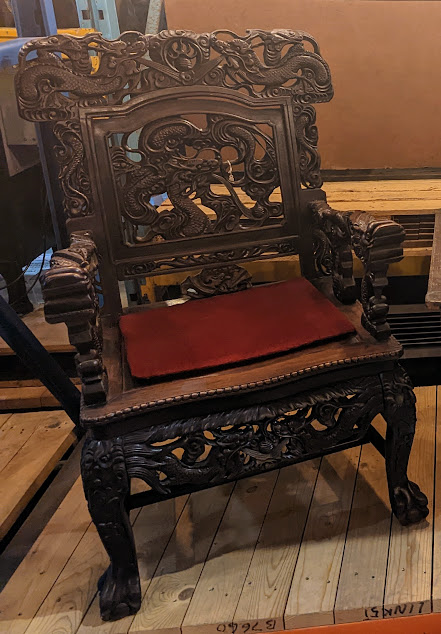
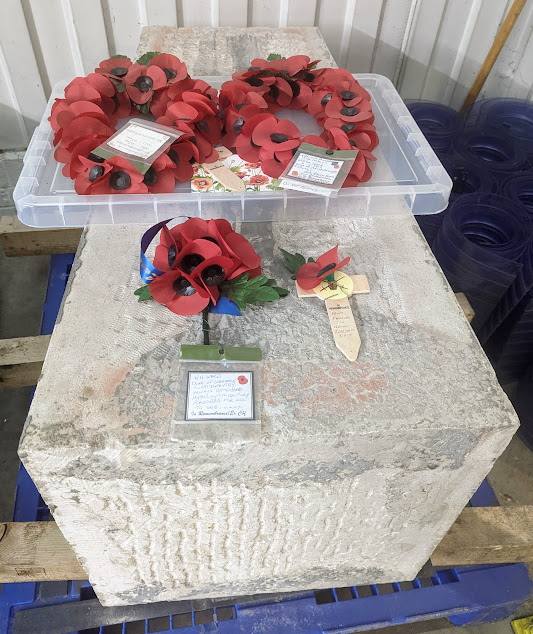
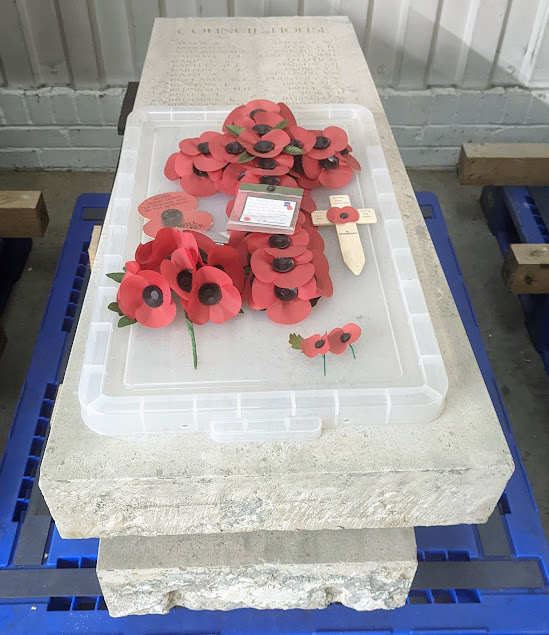
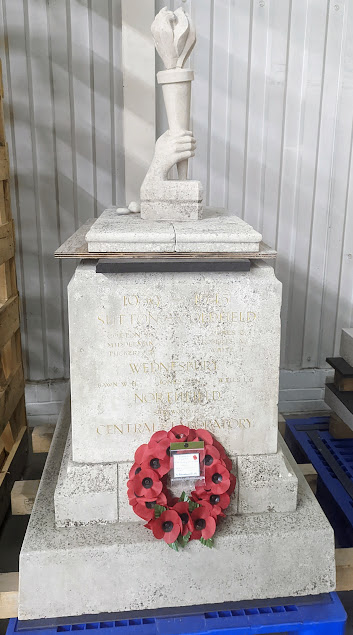
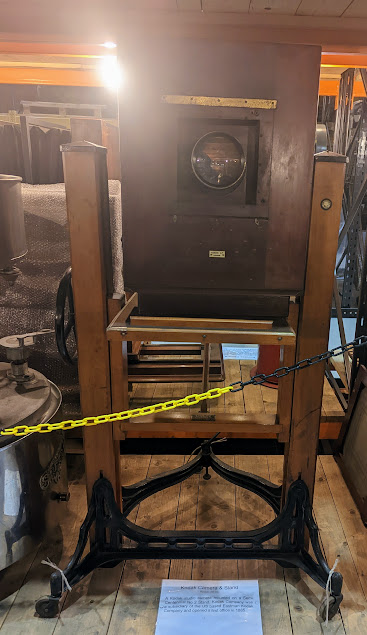
This is a Kodak studio camera mounted on a Semi Centenial No. 2 Stand. Kodak was a subsidry of the U.S. based Eastman Kodak Company and opened its first office in 1885.
Read about Kodak here.

Developed in the 1600’s, the magic lantern is an early type of image projector. It uses a concave mirror in front of a light source to gather light and project it through a slide. The light rays cross an aperture and hit a lens., which in turn throws the enlarged slide image onto a screen.
Read about the magic lantern here.
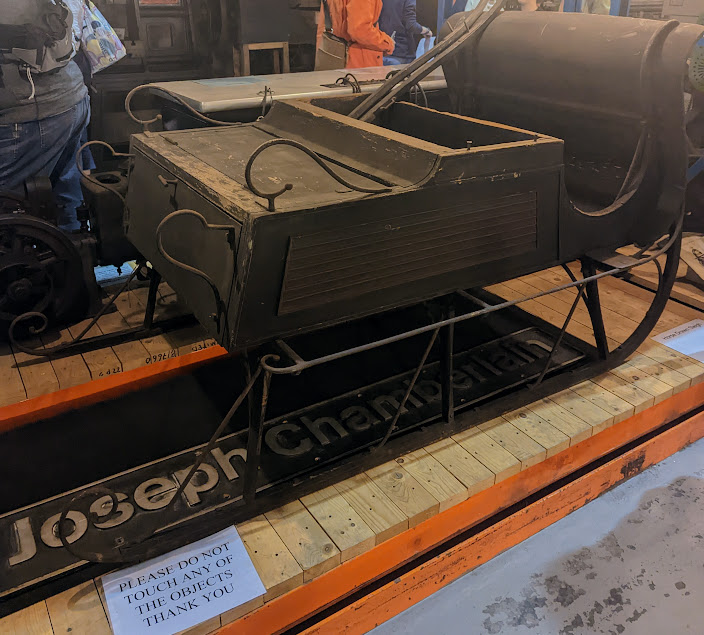
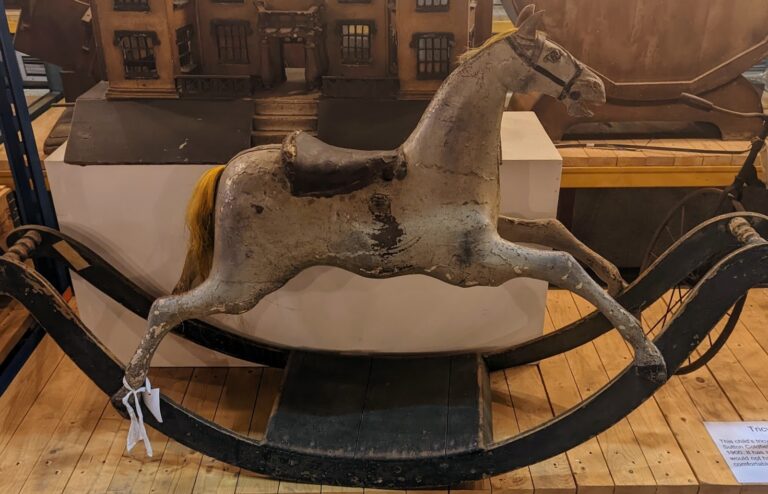
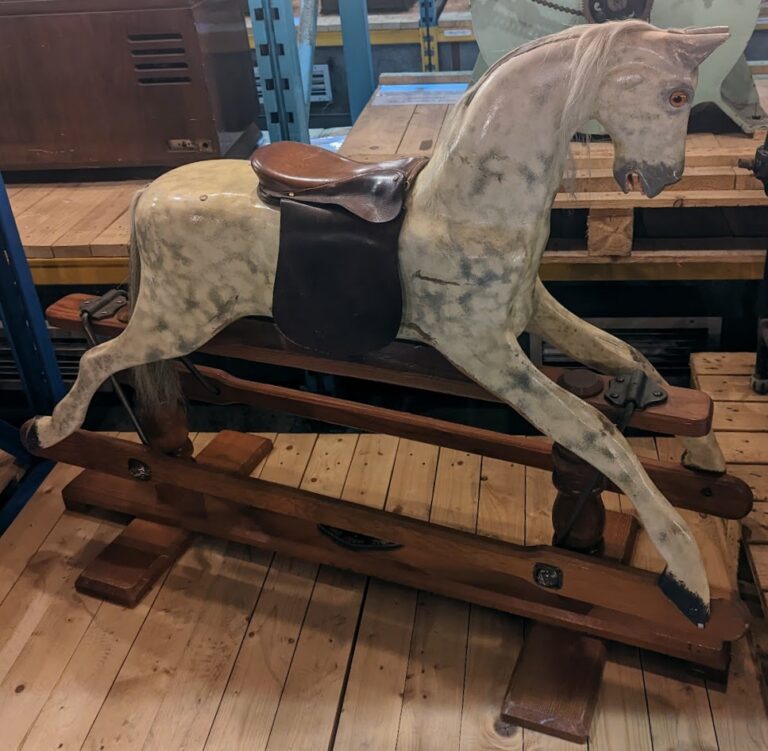
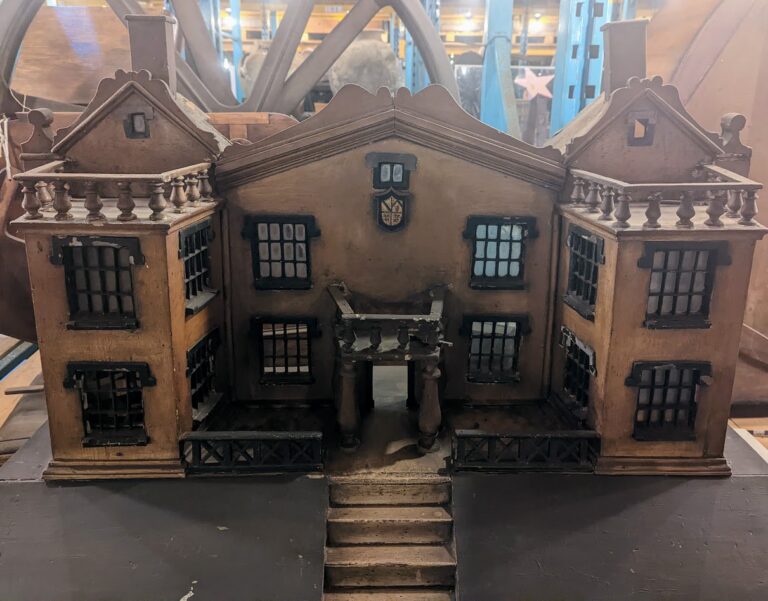
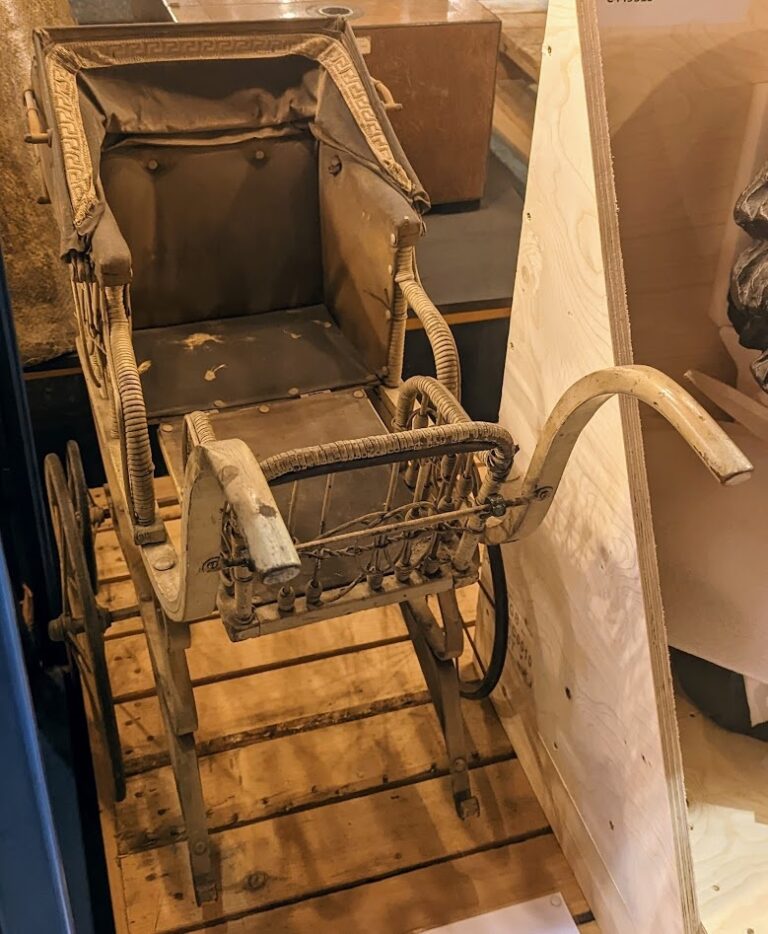
This doll’s pram was made by James Lloyd and Company, Hurst Street, Birmingham in the early 1900’s.
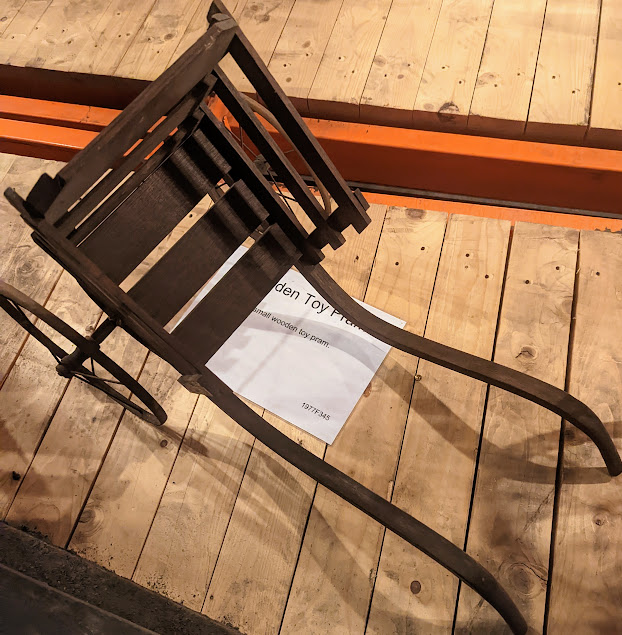
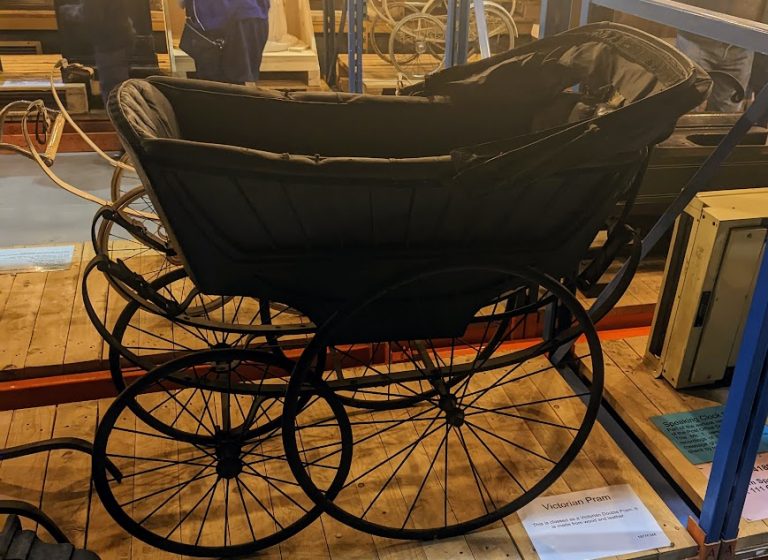
This is classed as a Victorian Double Pram. It is made from wood and leather.
Pram
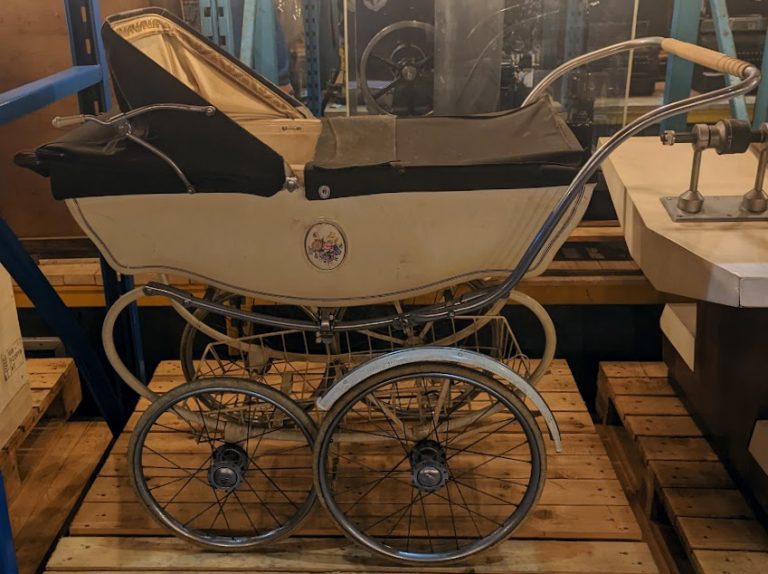
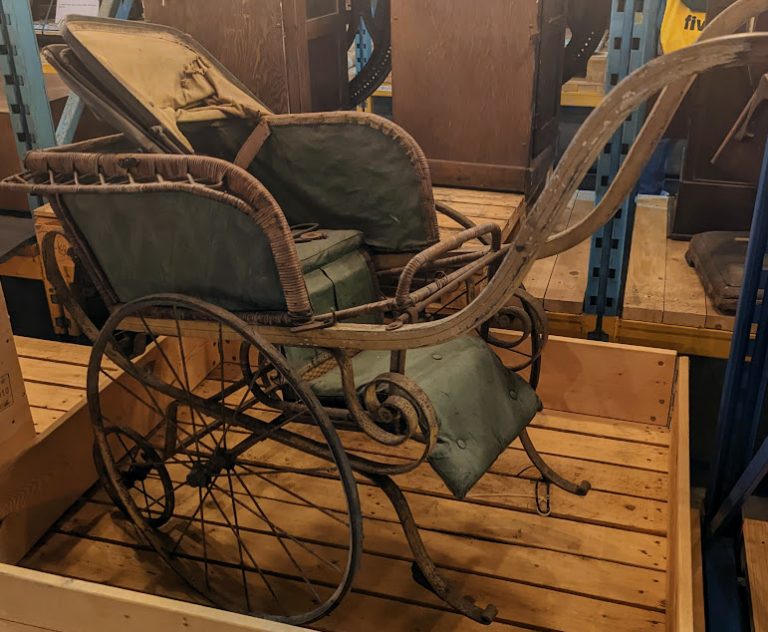
Local History: The Museum Collection Centre.
The Museum Collection: Photos – Page 1.
The Museum Collection: Photos – Page 2.
The Museum Collection: Photos – Page 3.
The Museum Collection: Photos – Page 4.
The Museum Collection: Photos – Page 5.
The Museum Collection: Photos – Page 6.
The Museum Collection: Photos – Page 7.
All the above images are copyright of Frank Parker.
Museum Collection Centre on Facebook.
Museum Collection Centre on Twitter.
Birmingham Museums Collection – Find out more about Birmingham’s collections including art and design, human history, natural science and science and industry categories. Each category contains sub-categories full of useful information and great photos.
Birmingham Museums Trust’s Digital Asset Resource – Official website. There is no registration or log-in required to use this website for out-of-copyright collection images Download free Public Domain image files up to 3mb in size with free Creative Commons licenses. You are entitled to unlimited downloads. Also, download free Audio Files complete with a license. These can be downloaded for non-commercial use only and attribution is required.
BirminghamMAG – Official YouTube channel. Birmingham Museums and Art Gallery provide world-class museums at the cultural heart of Birmingham.
Birmingham Museums – Official website.
Thinktank: Birmingham Science Museum – Official website.
Birmingham Museum And Art Gallery – Official website.
Aston Hall – Official website.
Blakesley Hall – Official website.
Museum Of The Jewellery Quarter – Official website.
Sarehole Mill – Official website.
Soho House – Official website.
Weoly Castle – Official website.
Aldridge Transport Museum – Official website. The museum is home of Aston Manor Road Transport Museum (A.M.R.T.M.).
Aldridge Transport Museum on Facebook.
Wikipedia – Official website. This is a free encyclopedia that anyone can edit.
Grace’s Guide – Official website. This is the leading source of historical information on industry and manufacturing in Britain. This web publication contains 149,969 pages of information and 235,611 images of early companies, their products and the people who designed and built them.
Luxury Prams – Official Website.

Here are more photos I took on my first visit to the Museum Collection Centre on 17/09/22.

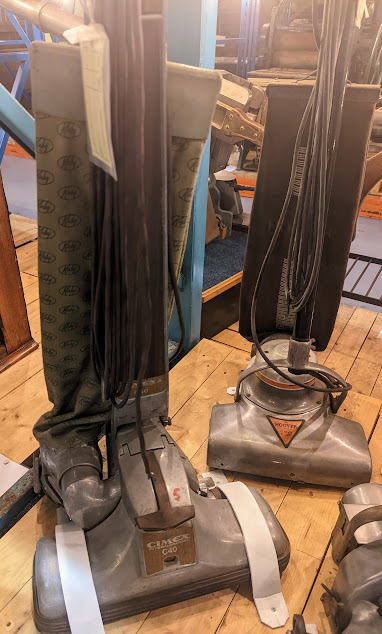
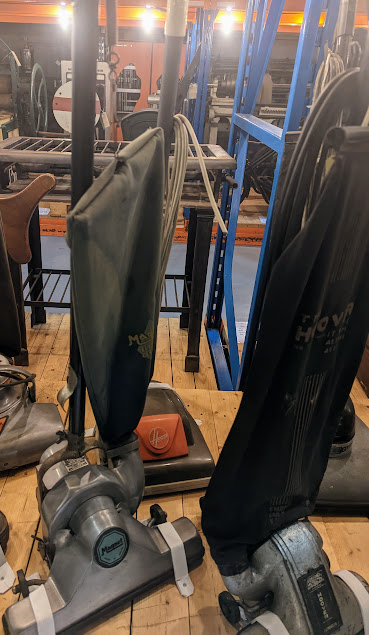
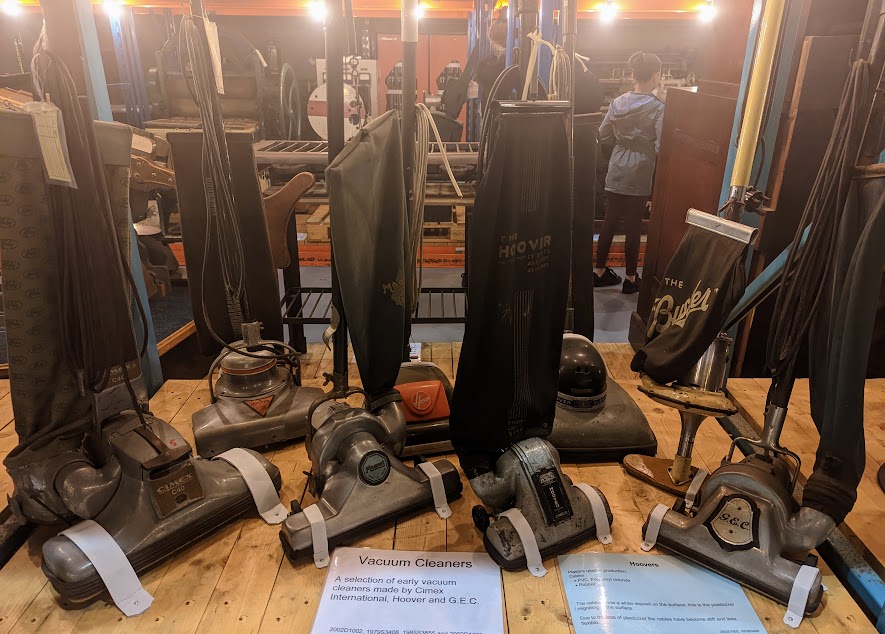
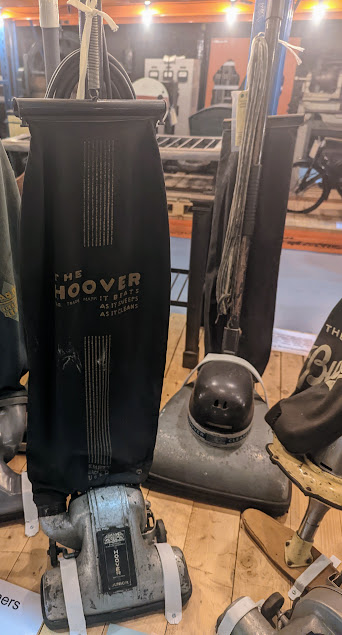
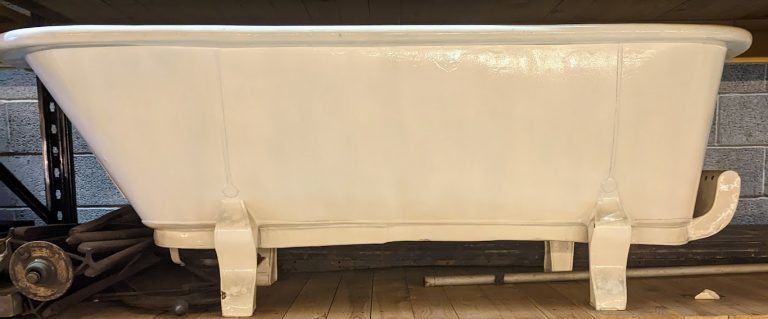
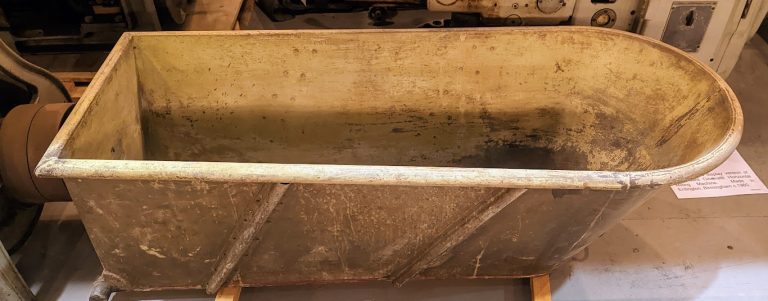
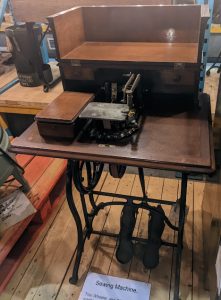
This Wheeler & Wilson Sewing machine was first patented in 1867. It was a domestic machine and it was used in Hall Green, Birmingham.
Read about Wheeler & Wilson here.
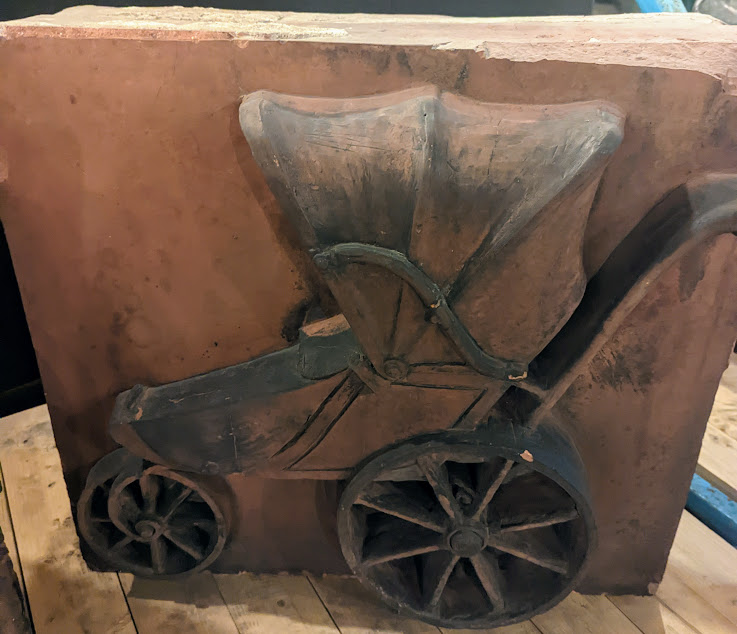
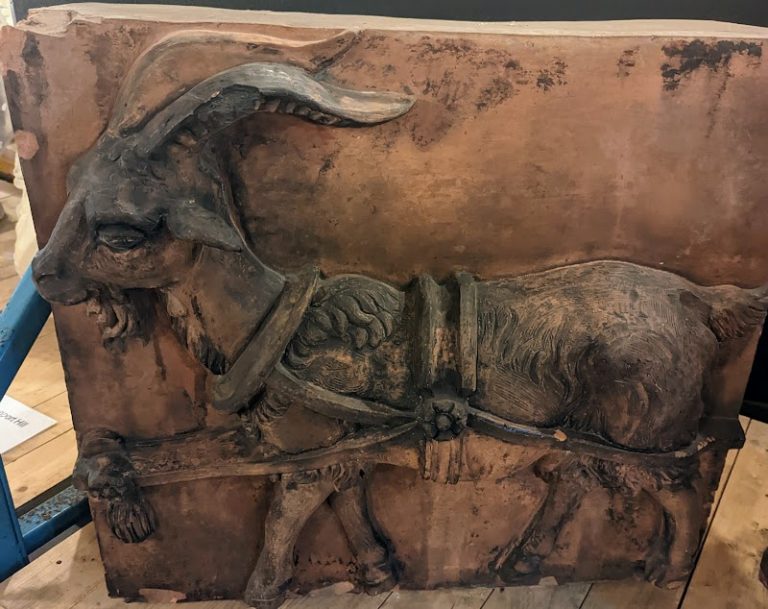
The two reliefs above were displayed outside Dunkley’s shop in the Bull Ring, Birmingham until it was demolished in the 1950s. Dunkley’s made prams and wheelchairs for the elderly and people with disabilities, and the Goat and Pram was its trademark.
Read about Dunkley prams here.
Read about Dunkley’s here.
Read about William Henry Dunkley here.
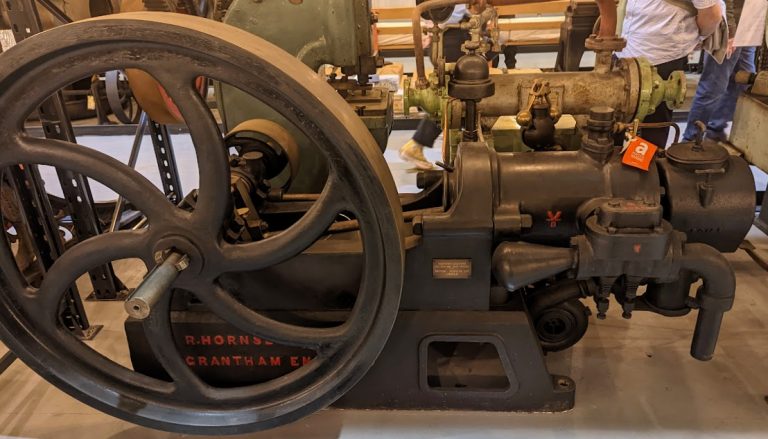
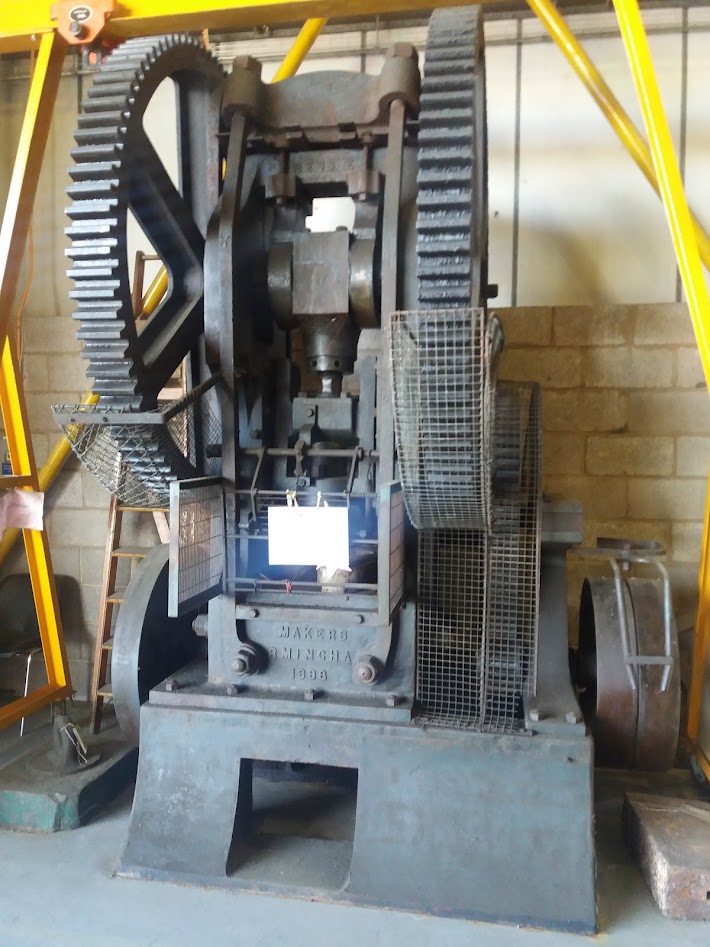
Made by Taylor and Challen, Birmingham in 1888, this press is from the factory of Gordon & Munro Limited.
Read about Taylor and Challen here.
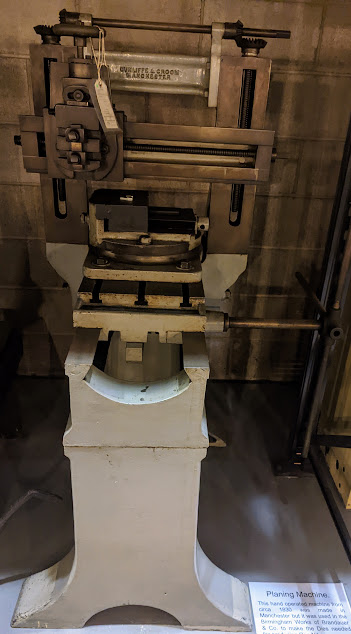
This hand-operated machine from circa 1830 was made in Manchester but it was used in the Birmingham Works of Branadauer & Co. to make the Dies needed for producing Pen Nibs.
Read about Planing Machines here.
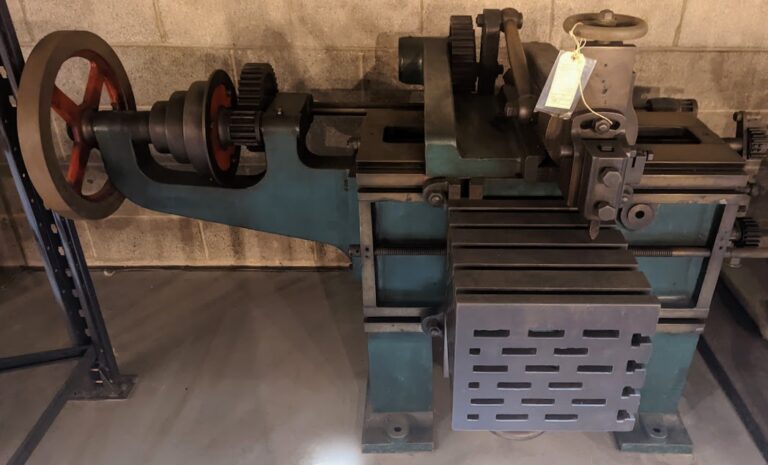
More versatile than a Planing Machine, Shapers were used to produce flat surfaces on shaped metal objects. Angled cuts were possible and some grooves could be cut without using a Milling M/c.
Read about Shaping Machines here.

Machines like this were used in the early days of the Motor Trade to make curved metal shapes by distorting flat sheets. One use of this was would be to hand-produce separate Mudguards.
Read about Wheeling Machines here.
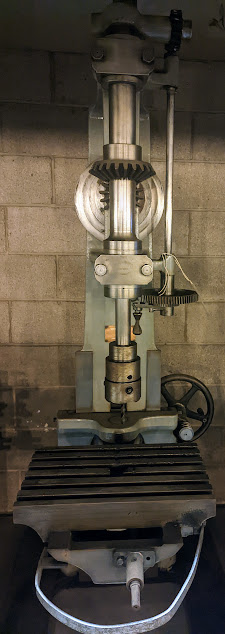
Sir Joseph Whitworth was famed for the accuracy of his machine tools in the mid-late 1800’s. He is regarded as the founding father of Mass Production in England as interchangeability needs accuracy.
Read about Drilling Machines here.
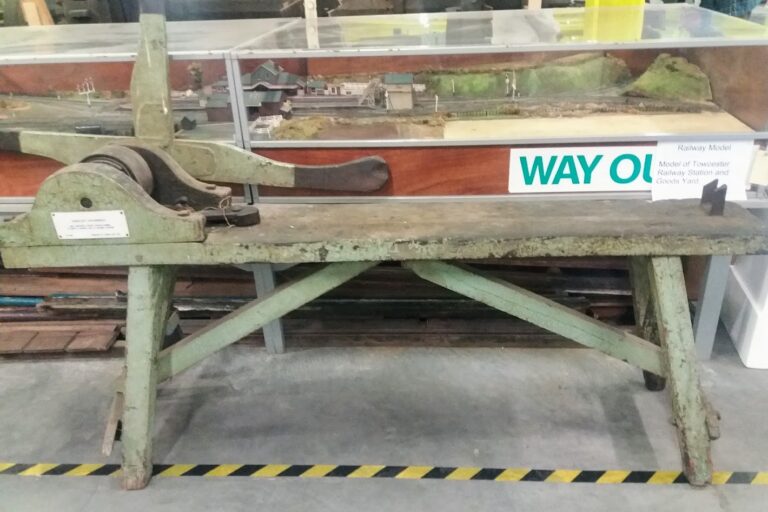
This Draw bench is from the workshop of Joseph Fray Limited, Albion Street, Birmingham.
Read about Joseph Fray Limited here.
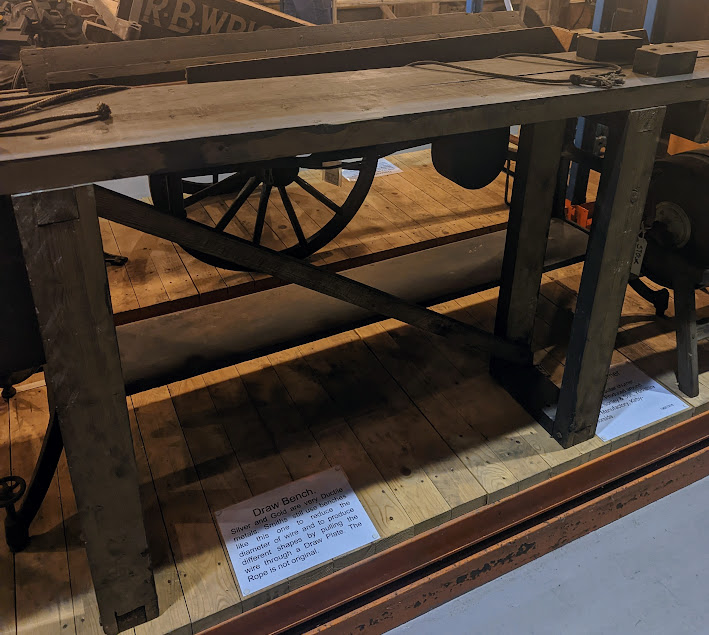
Silver and Gold are very Ductile metals. Smiths still use benches like this one to reduce the diameter of the wire and to produce different shapes by pulling the wire through a Draw Plate. The Rope is not original.
Read about Draw Benches here.
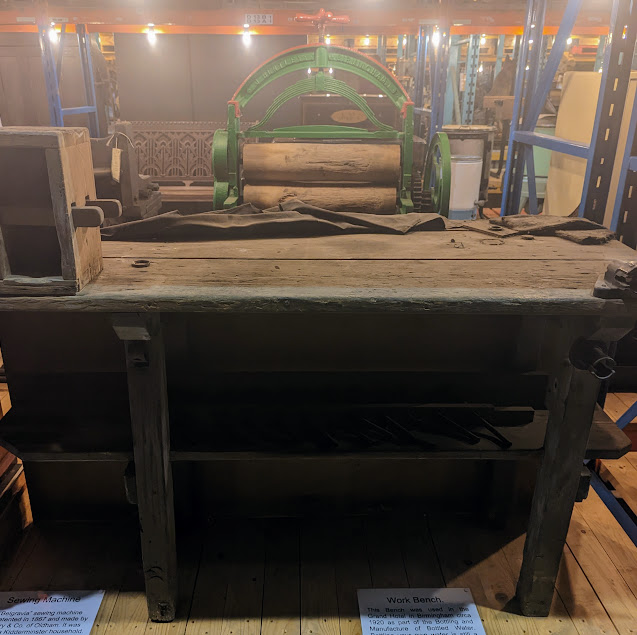
This Bench was used in the Grand Hotel in Birmingham circa 1920 as part of the Bottling and Manufacture of bottled water. Bottling your own water is still a common practice today in Hotels.
Read about Work Benches here.
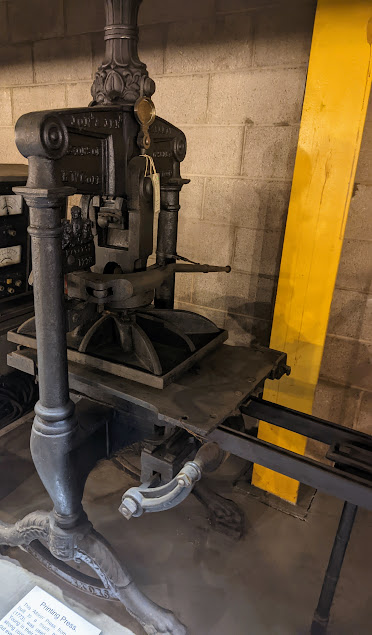
This Albion Press, from 1841 but built to a much earlier patent (1773), was used by Herbert and Young in their Printing Works. The strong construction methods helped put even pressure on the plate.
Read about the Albion Press here.
Local History: The Museum Collection Centre.
The Museum Collection: Photos – Page 1.
The Museum Collection: Photos – Page 2.
The Museum Collection: Photos – Page 3.
The Museum Collection: Photos – Page 4.
The Museum Collection: Photos – Page 5.
The Museum Collection: Photos – Page 6.
The Museum Collection: Photos – Page 7.
All the above images are copyright of Frank Parker.
Museum Collection Centre on Facebook.
Museum Collection Centre on Twitter.
Birmingham Museums Collection – Find out more about Birmingham’s collections including art and design, human history, natural science and science and industry categories. Each category contains sub-categories full of useful information and great photos.
Birmingham Museums Trust’s Digital Asset Resource – Official website. There is no registration or log-in required to use this website for out-of-copyright collection images Download free Public Domain image files up to 3mb in size with free Creative Commons licenses. You are entitled to unlimited downloads. Also, download free Audio Files complete with a license. These can be downloaded for non-commercial use only and attribution is required.
BirminghamMAG – Official YouTube channel. Birmingham Museums and Art Gallery provide world-class museums at the cultural heart of Birmingham.
Birmingham Museums – Official website.
Thinktank: Birmingham Science Museum – Official website.
Birmingham Museum And Art Gallery – Official website.
Aston Hall – Official website.
Blakesley Hall – Official website.
Museum Of The Jewellery Quarter – Official website.
Sarehole Mill – Official website.
Soho House – Official website.
Weoly Castle – Official website.
Wikipedia – Official website. This is a free encyclopedia that anyone can edit.
Grace’s Guide – Official website. This is the leading source of historical information on industry and manufacturing in Britain. This web publication contains 149,969 pages of information and 235,611 images of early companies, their products and the people who designed and built them.

Here are more photos I took on my first visit to the Museum Collection Centre on 17/09/22.
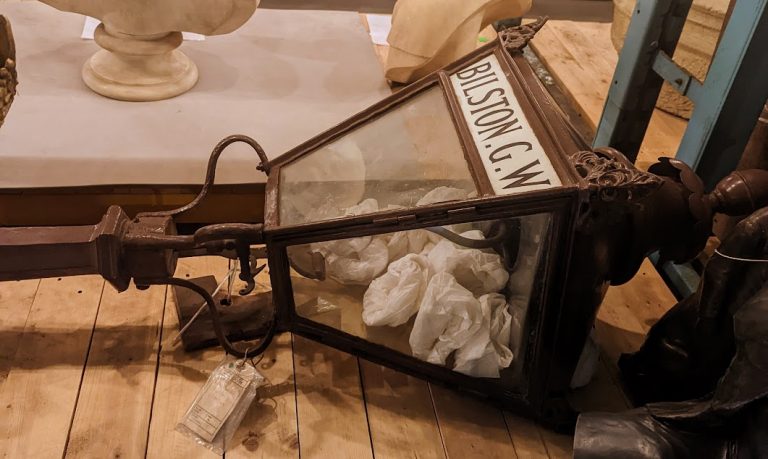
This gas lantern is from Bilston station.
Read about Bilston station here.
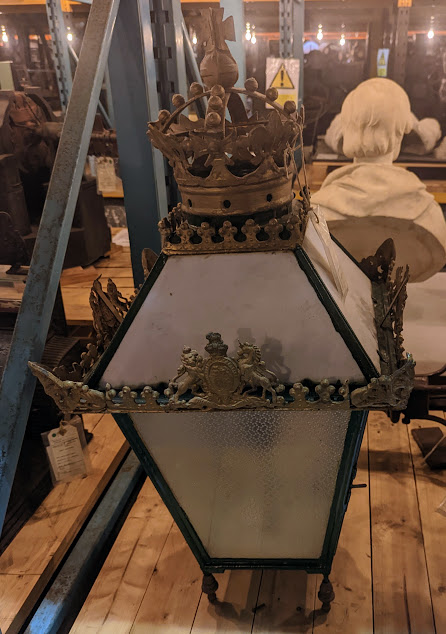
This gas lantern is from the station used by the royal family when they visited Sandringham.
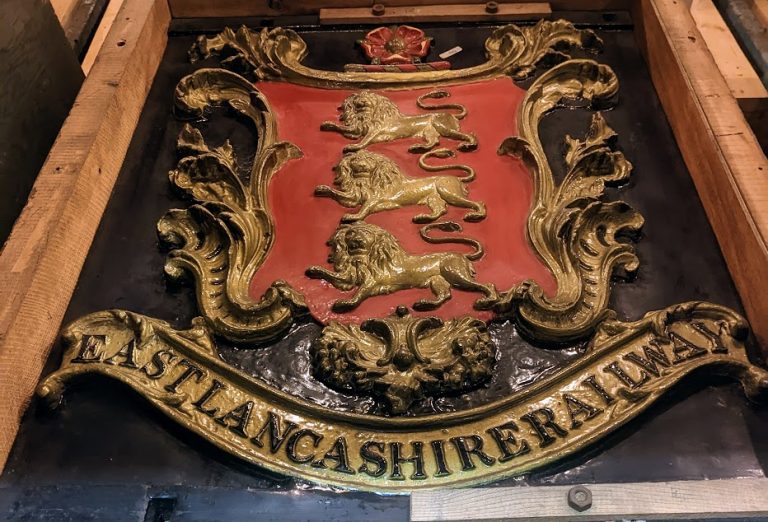
This cast iron plaque carries the crest of the East Lancashire Railway, which operated as an independent company in the Accrington, Blackburn and Burnley areas between 1844 – 1859.
Read about the East Lancashire Railway here.
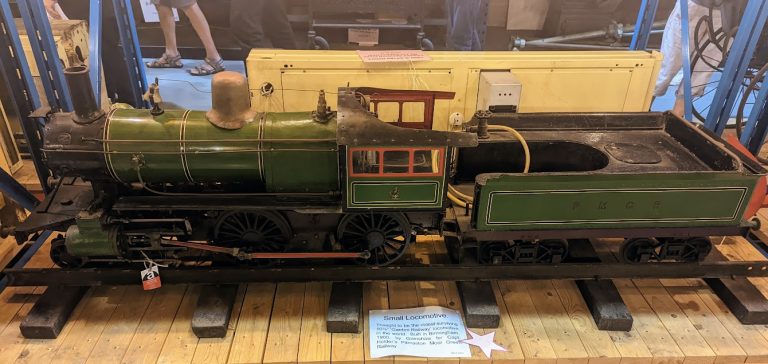
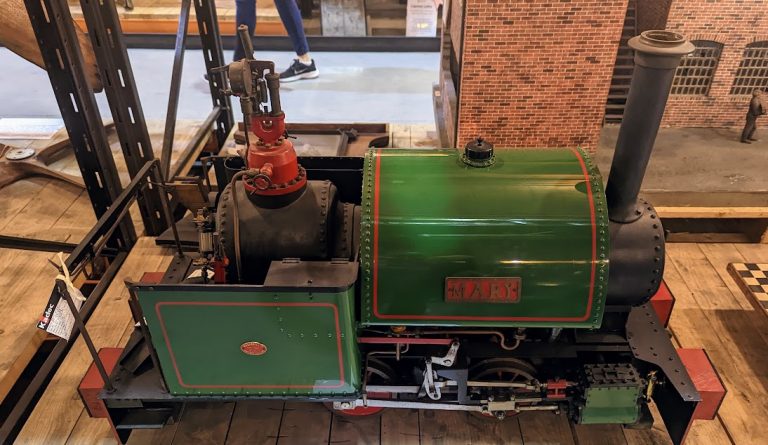
This is a model of the 0-4-0 locomotive Mary. The original was built by W.G. Bagnall Limited, Engineers, Stafford.
Read about W.G. Bagnall here.

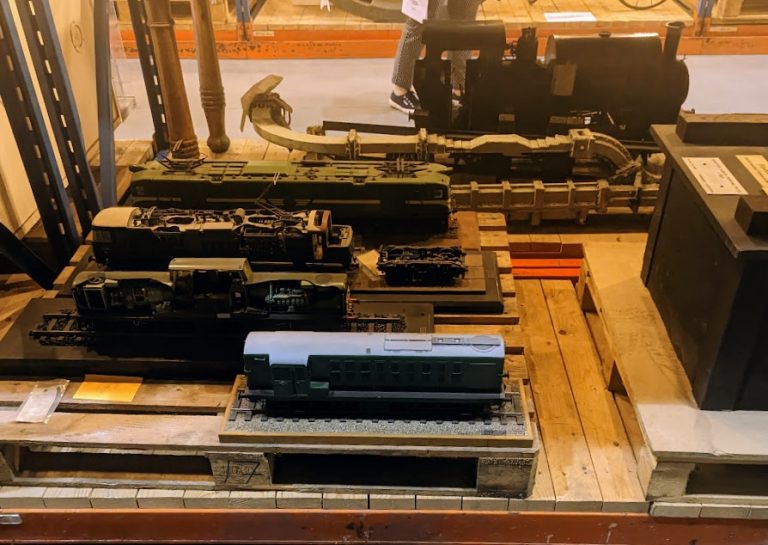
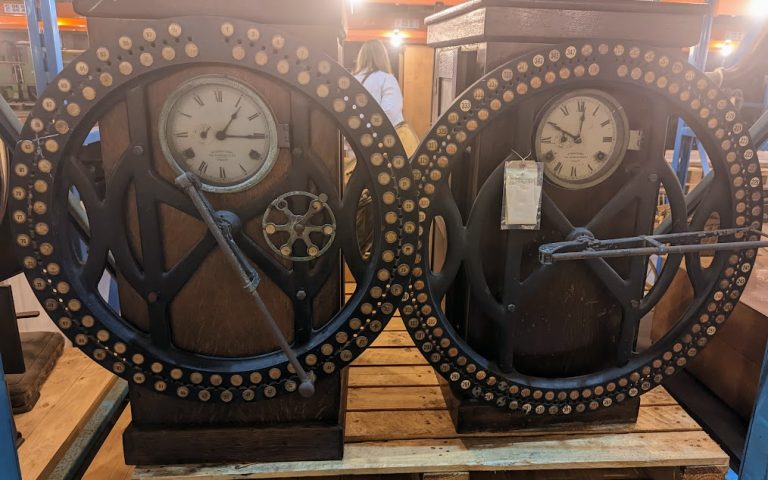
These two clocking-in machines were made by the International Time Recording Company around 1920. They were quite laborious to operate.
Read about the International Time Recording Company here.
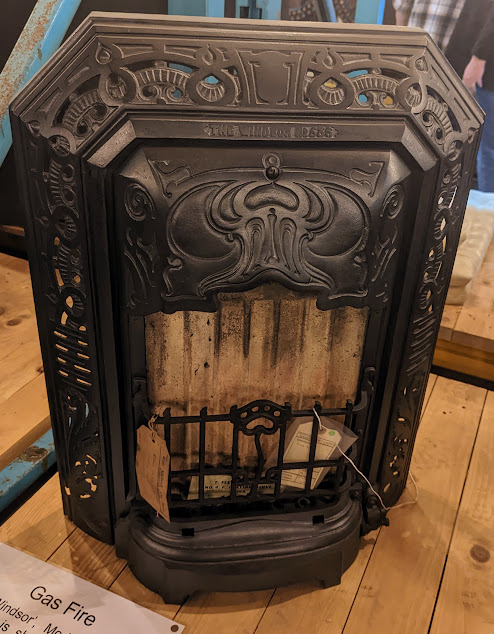
This Flavel Windsor, Model No. 536, Gas Fire is shown here without the ceramic elements which radiated the heat out into the room. This Fire is part of the West Midlands Gas Collection.
Read about Flavel here.
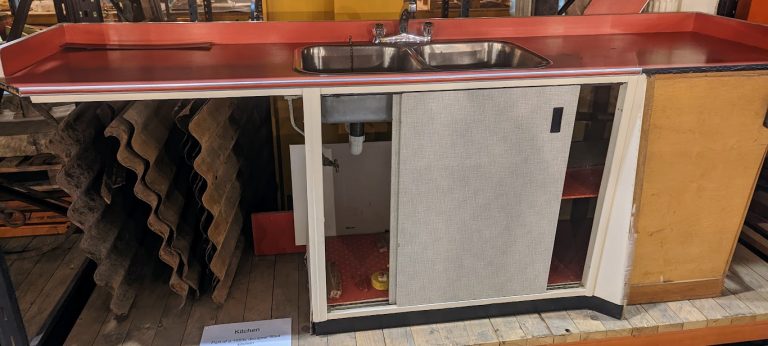
Part of a designer 1950’s fitted kitchen.
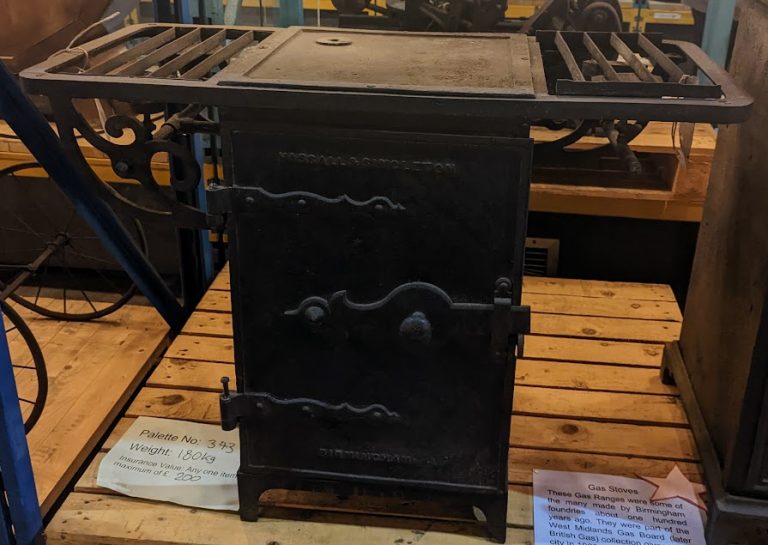

The two Gas Ranges above were some of the many made by Birmingham foundries about 100 years ago. They were part of the West Midlands Gas Board (later to become British Gas) collection given to the city in 1962.
Read about the West Midlands Gas Board here.

Cannon of Bilston in the West Midlands introduced their first gas cookers in 1895 and became a leading brand in this domestic kitchen appliance. This particular gas cooker style was in popular use by the 1950’s in homes across the country.
Read about Cannon here.
Washing Dolly
This is an early attempt at trying to make washing easier at a time before washing machines. The dolly was used to agitate laundry and placed in a tub with hot water and soap. This one was made in Tyseley, Birmingham.
Read about the washing dolly here.

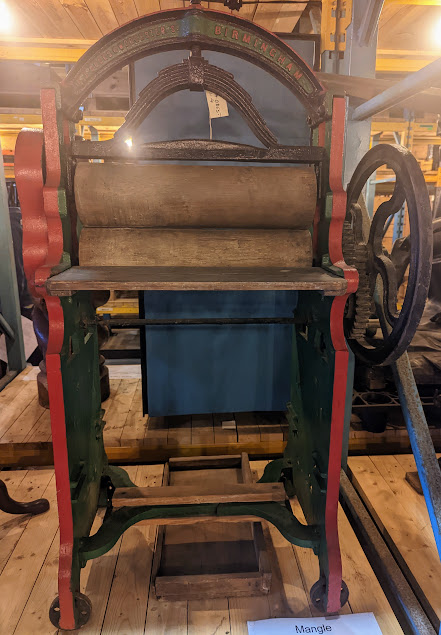
Before the 1950’s most houses had a mangle to domestically squeeze excess water from washed clothes. This one was made by F.J. Cocks, 6 Worcester Street, Birmingham.
Read about the Mangle here.
This mangle was made by J. Bentley of Birmingham and dates back to around 1875 – 1925.
Read about the Mangle here.
Mangles
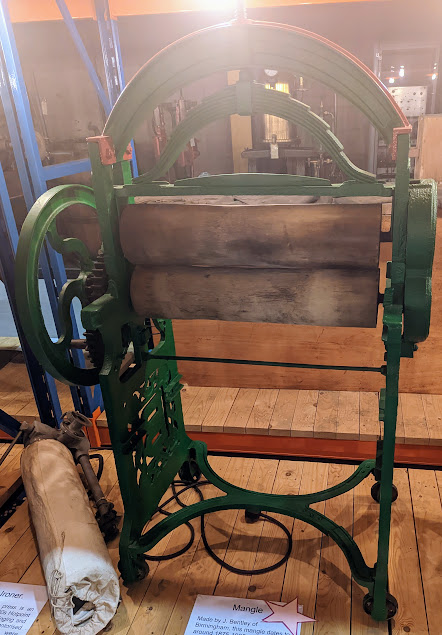
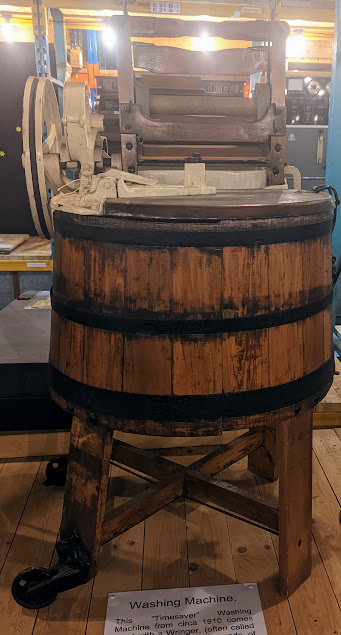
This Timesaver Washing Machine, circa 1910, comes fitted with a Wringer (also known as a mangle). It was principally made of wood. This machine came from the Stourbridge area.

Made by W. Summerscales & Son (later to be changed to W. Summerscales & Sons) of Coney Lane Mills, Keighley, Yorkshire in 1865 this design won awards at agricultural shows around Northern England in the 1860’s and it was exhibited at the International Exhibition in 1862.
Read about W. Summerscales & Sons here.
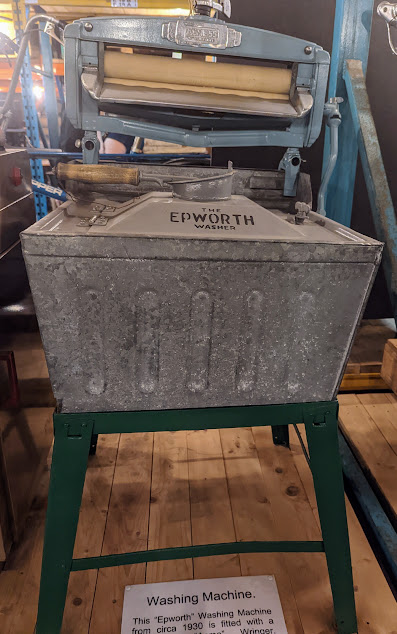
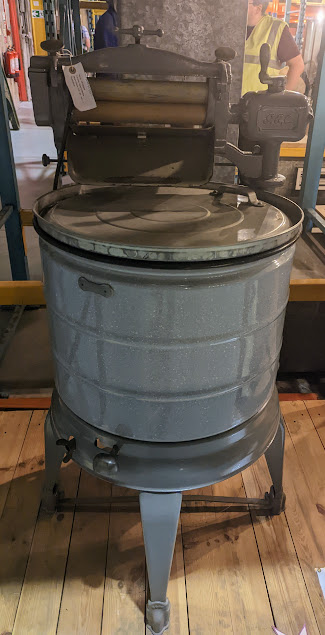
This machine was made in Birmingham by the General Electric Company (G.E.C.) in 1935. It was powered by electricity. The growing use of electricity both at home and at work ensured a great demand for G.E.C.’s products and the company expanded both at home and overseas.
Read about the General Electric Company here.
Local History: The Museum Collection Centre.
The Museum Collection: Photos – Page 1.
The Museum Collection: Photos – Page 2.
The Museum Collection: Photos – Page 3.
The Museum Collection: Photos – Page 4.
The Museum Collection: Photos – Page 5.
The Museum Collection: Photos – Page 6.
The Museum Collection: Photos – Page 8.
All the above images are copyright of Frank Parker.
Museum Collection Centre on Facebook.
Museum Collection Centre on Twitter.
Birmingham Museums Collection – Find out more about Birmingham’s collections including art and design, human history, natural science and science and industry categories. Each category contains sub-categories full of useful information and great photos.
Birmingham Museums Trust’s Digital Asset Resource – Official website. There is no registration or log-in required to use this website for out-of-copyright collection images Download free Public Domain image files up to 3mb in size with free Creative Commons licenses. You are entitled to unlimited downloads. Also download free Audio Files complete with a license. These can be downloaded for non-commercial use only and attribution is required.
BirminghamMAG – Official YouTube channel. Birmingham Museums and Art Gallery provide world-class museums at the cultural heart of Birmingham.
Birmingham Museums – Official website.
Thinktank: Birmingham Science Museum – Official website.
Birmingham Museum And Art Gallery – Official website.
Aston Hall – Official website.
Blakesley Hall – Official website.
Museum Of The Jewellery Quarter – Official website.
Sarehole Mill – Official website.
Soho House – Official website.
Weoly Castle – Official website.
Wikipedia – Official website. This is a free encyclopedia that anyone can edit.
Grace’s Guide – Official website. This is the leading source of historical information on industry and manufacturing in Britain. This web publication contains 149,969 pages of information and 235,611 images on early companies, their products and the people who designed and built them.

Here are more photos I took on my first visit to the Museum Collection Centre on 17/09/22.

This 3.5 Litre model was built in 1971 in Solihull and restored to concours condition by its former owner. The mileage shown is only 45,462. The P5B had a 3528cc V8 engine and was in production from 1967 to 1973 replacing the P5 model (2955cc from 1958 to 1967).
Read about the Rover P5 here.
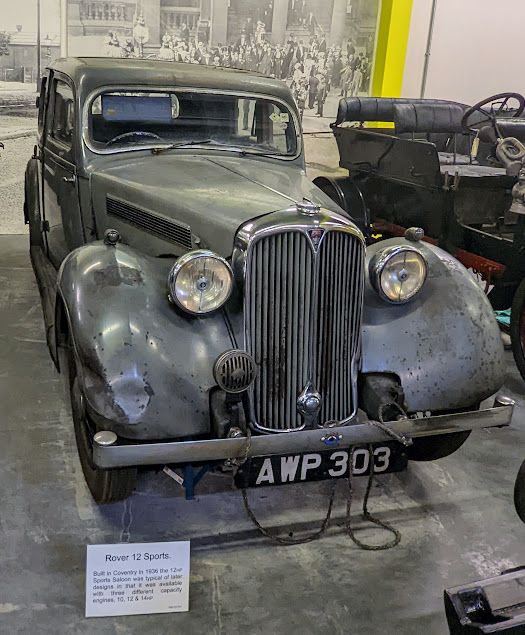
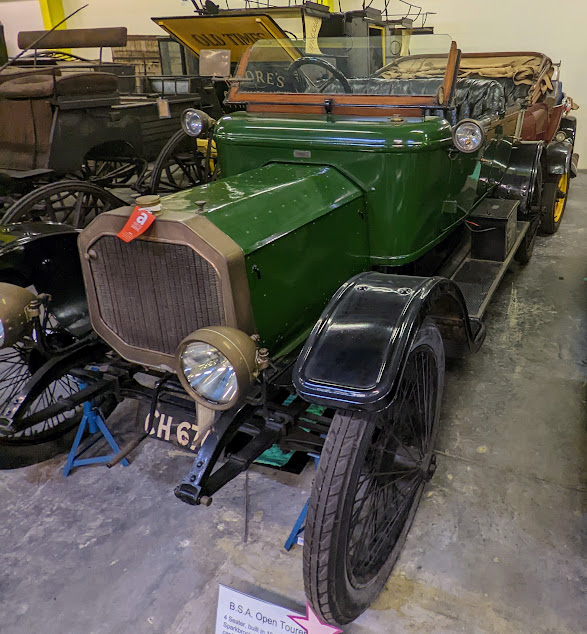
With one of the earliest uses of steel panels in cars, this 4-seater was built at the Sparkbrook Works of B.S.A. in Birmingham. It has the legendary Knight Double Sleeve Valve engine.
Read about B.S.A. cars here.
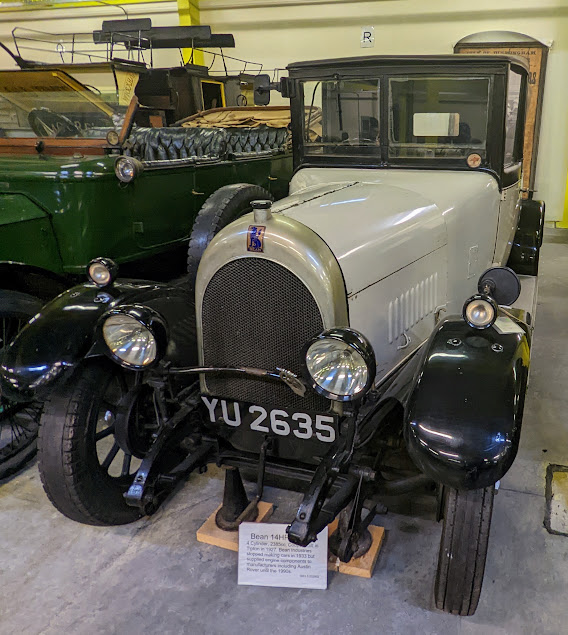
This 4-cylinder 2385cc built Coupe was built in Tipton in 1927. Bean industries stopped making cars in 1933 but supplied engine components to manufacturers including Austin Rover until the 1900’s.
Read about Bean cars here.
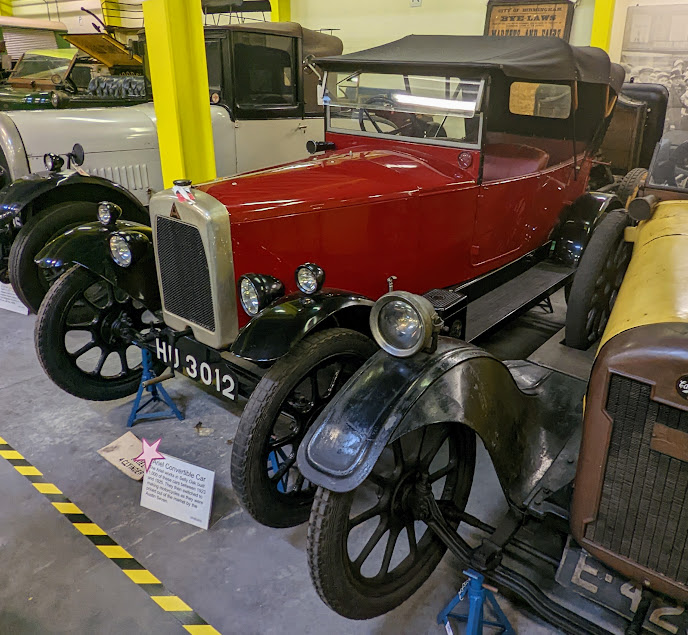
The Ariel works in Selly Oak, Birmingham, built 1,000 of these cars between 1923 and 1925. They then switched to making motorcycles as they were priced out of the market by the Austin Seven.
Read about the Ariel Motor Company here.
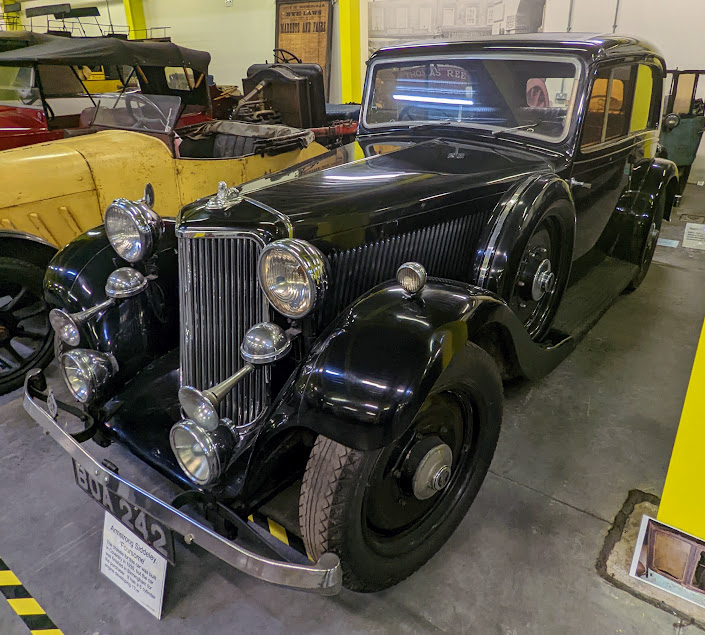
The chassis for this car was built in Coventry in 1935, but the car was finished in Birmingham for the purchaser. It has a 6-cylinder engine developing 17HP.
Read about Armstrong Siddeley here.
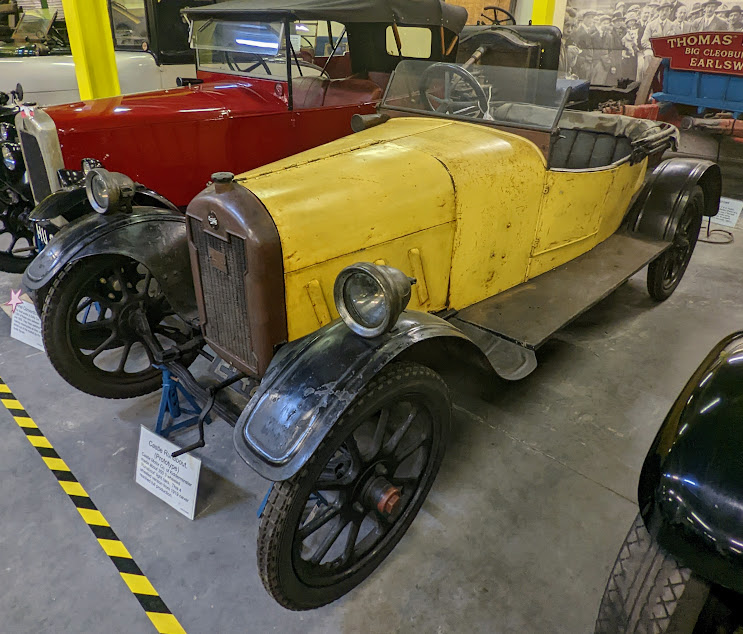
This car was a prototype and was made by the Castle Motor Company of Kidderminster. They made about 350 3-wheeled Runabout light cars. The 4-wheeled version from 1919 never reached full production.
Read about the Castle Motor Company here.
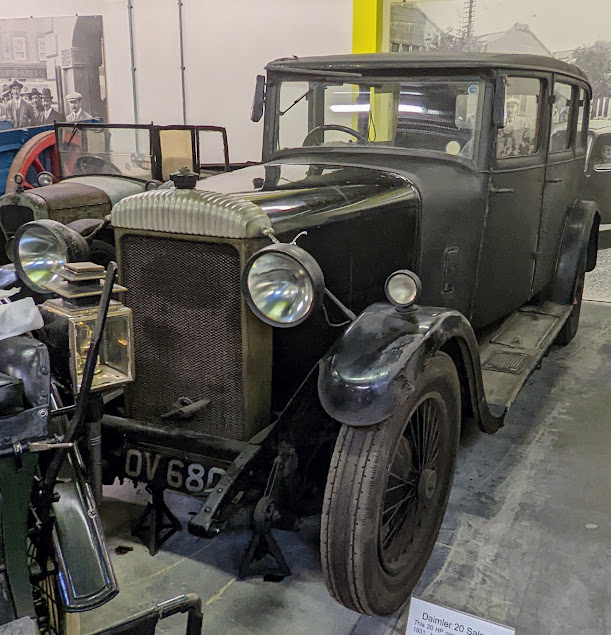
Read about the Daimler Company here.
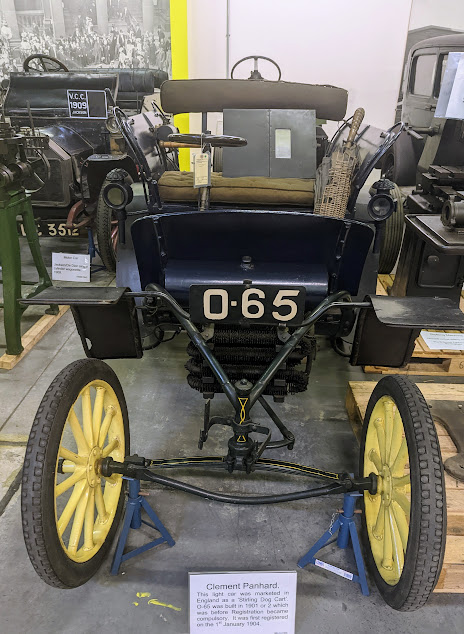
This light car was marketed in England as a Stirling Dog Cart. 0-65 were built in 1901 or 2 which was before Registration became compulsary. It was first registered on January the 1st 1904.
Read about Clement Panhard here.

This car was built by the Jackson Automobile Company in 1909 and was a single cylinder wagonette.
Read about the Jackson Automobile Company here.
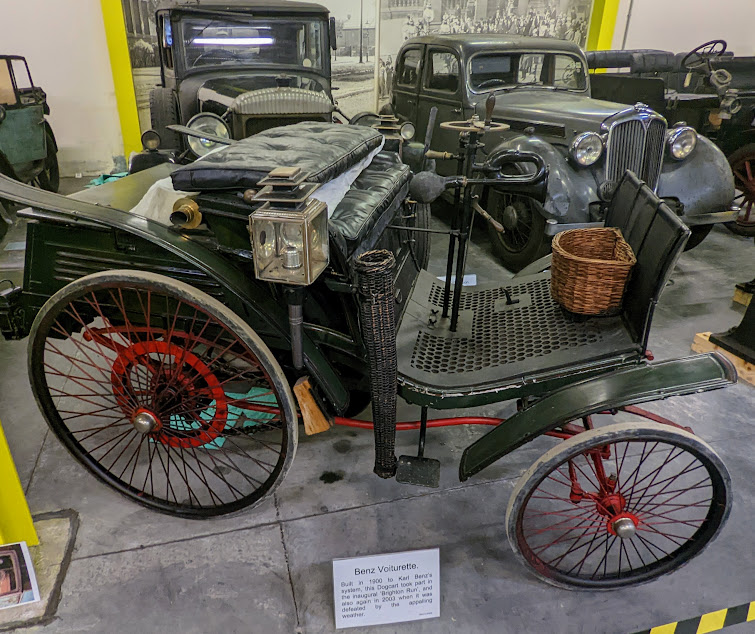
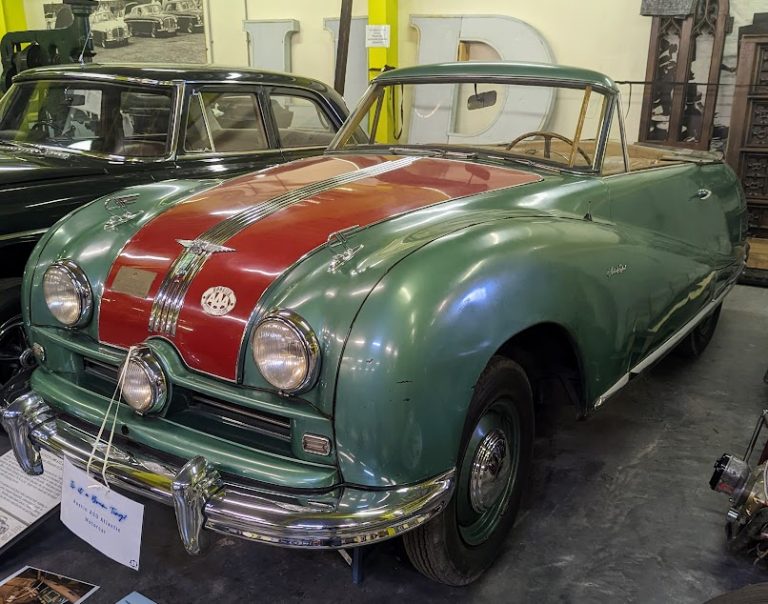
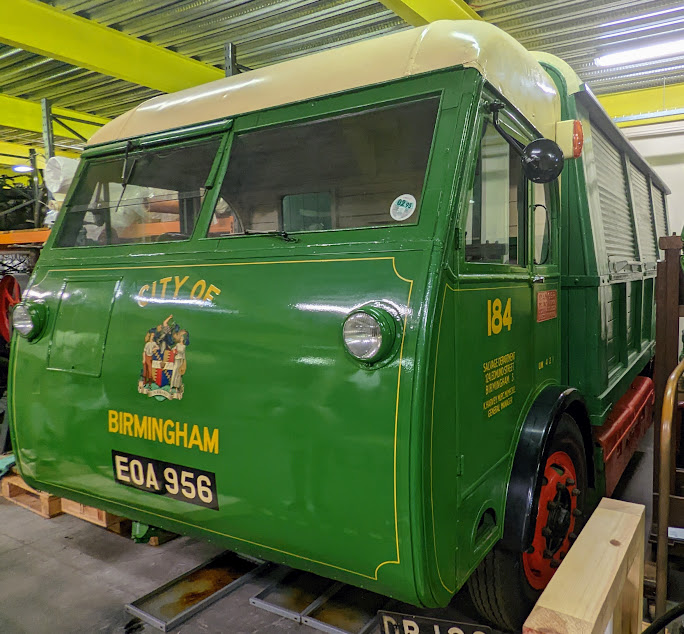
This 4-ton electric dust cart was used in Birmingham between 1938 and 1971 and was developed as the result of a collaboration between the Birmingham salvage department and Electricars based on the salvage department’s experience with its previous electric vehicles. They were replaced by diesel-powered designs.
Read about the DV4 Electric Dust Cart here.
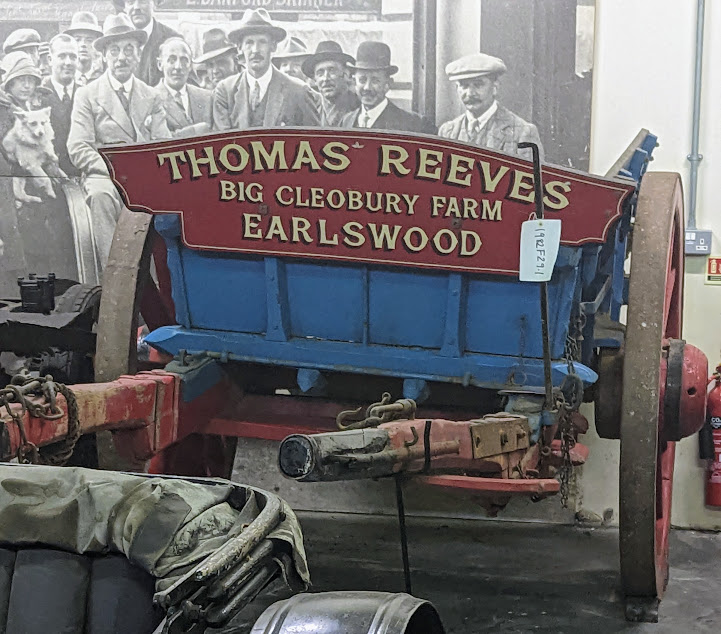
Made in 1945 by J. and A. Inston, Wheelwrights, of Bartley Green, Birmingham, at a cost of £50. It was one of the last carts to be made locally using traditional methods. Its present livery dates from the early 1960’s.
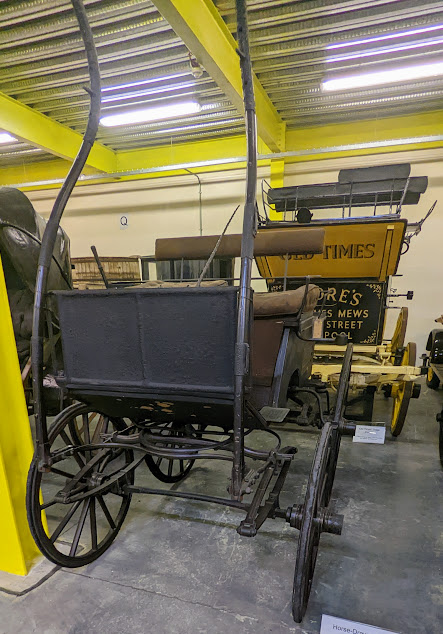
This is a horse drawn vehichle, with a compartment for carrying your dog.
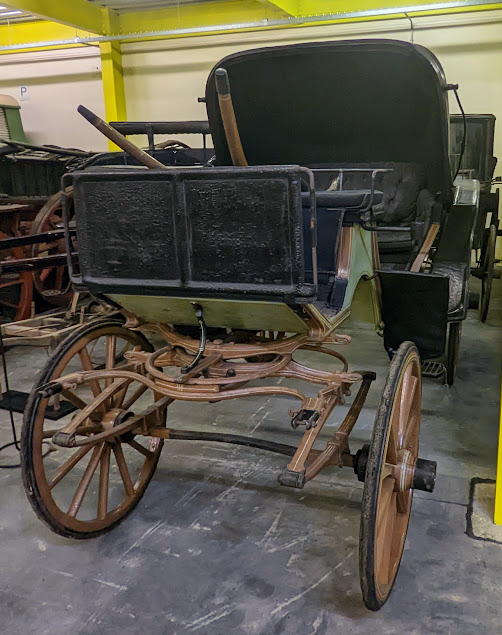
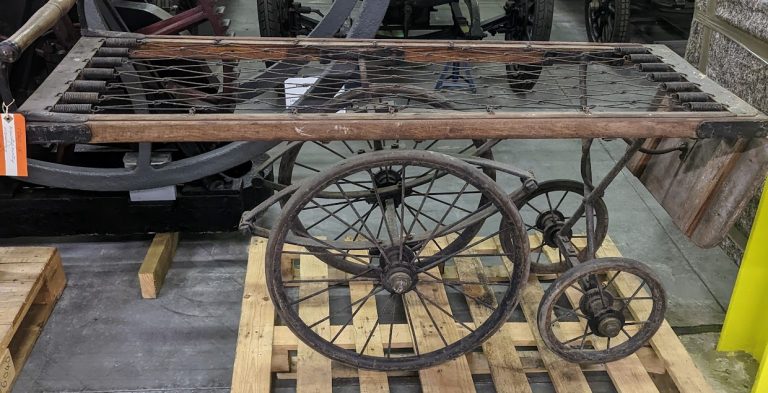
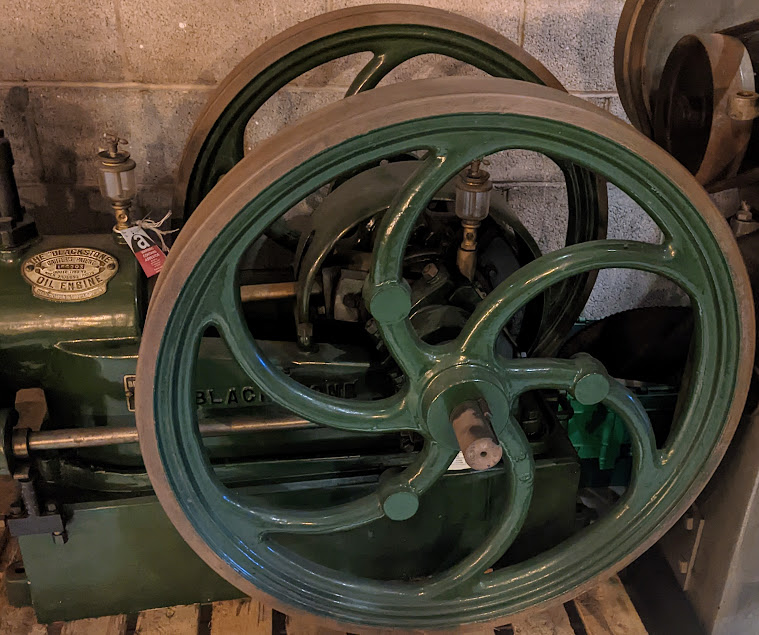
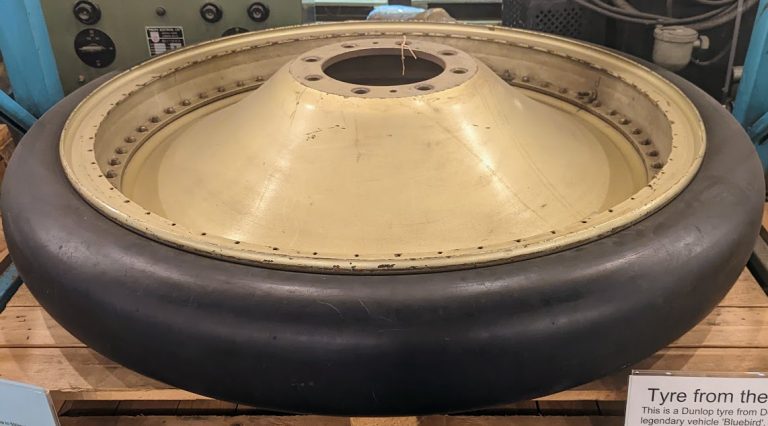
This is a Dunlop tyre from Donald Campbell’s legendery vehicle Bluebird. In July 1964 he claimed the land speed record of 403.10 mph at Lake Eyre, Australia, beating the record set by John Cobb in 1947. In January 1967 Donald Campbell died in an accident, in his boat named Bluebird, at Lake Coniston, Cumbria.
Read about the Bluebird here.
Read about Donald Campbell here.
Read about Dunlop here.

This generator provided electricity for the Lizard Lighthouse. It was made by Auguste de Meritens, Paris in 1880. Turning at 900 rpm it produced 3KW at 32 volts AC and 120 cps.
Local History: The Museum Collection Centre.
The Museum Collection: Photos – Page 1.
The Museum Collection: Photos – Page 2.
The Museum Collection: Photos – Page 3.
The Museum Collection: Photos – Page 4.
The Museum Collection: Photos – Page 6.
The Museum Collection: Photos – Page 7.
The Museum Collection: Photos – Page 8.
All the above images are copyright of Frank Parker.
Museum Collection Centre on Facebook.
Museum Collection Centre on Twitter.
Birmingham Museums Collection – Find out more about Birmingham’s collections including art and design, human history, natural science and science and industry categories. Each category contains sub-categories full of useful information and great photos.
Birmingham Museums Trust’s Digital Asset Resource – Official website. There is no registration or log-in required to use this website for out-of-copyright collection images Download free Public Domain image files up to 3mb in size with free Creative Commons licenses. You are entitled to unlimited downloads. Also download free Audio Files complete with a license. These can be downloaded for non-commercial use only and attribution is required.
BirminghamMAG – Official YouTube channel. Birmingham Museums and Art Gallery provide world-class museums at the cultural heart of Birmingham.
Birmingham Museums – Official website.
Thinktank: Birmingham Science Museum – Official website.
Birmingham Museum And Art Gallery – Official website.
Aston Hall – Official website.
Blakesley Hall – Official website.
Museum Of The Jewellery Quarter – Official website.
Sarehole Mill – Official website.
Soho House – Official website.
Weoly Castle – Official website.
Wikipedia – Official website. This is a free encyclopedia that anyone can edit.
Scratchpad – Official website. You can instantly create a free Fandom wiki for an idea of any size, and be up and running in a few minutes.

Here are the photos I took on my first visit to the Museum Collection Centre on 17/09/22.
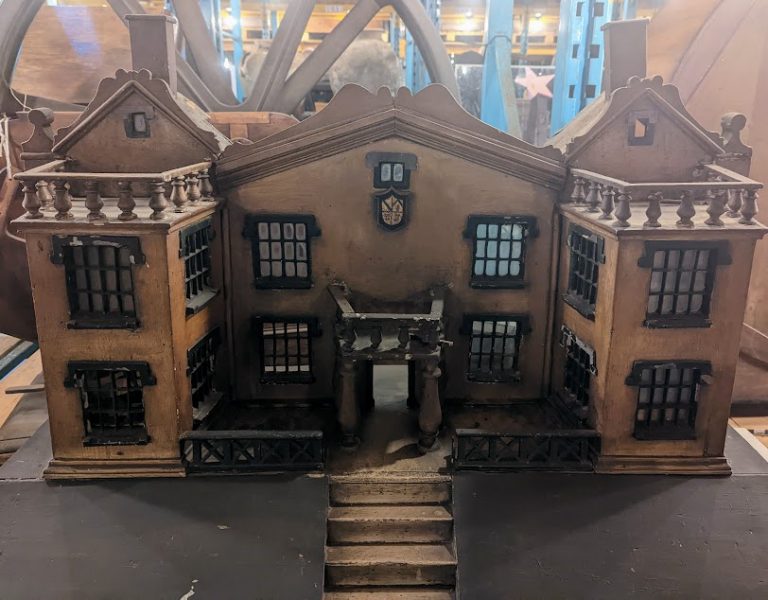
Doll’s House

Doll’s Pram

Toy Pram

Pram

Victorian Pram

Push Chair

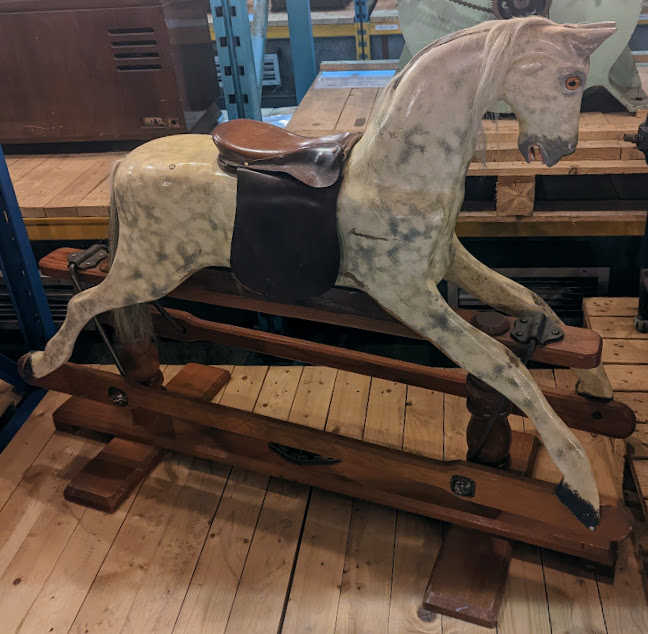
Rocking Horse

Typesetting Machine

Typographic Composing Machine

Printing Press
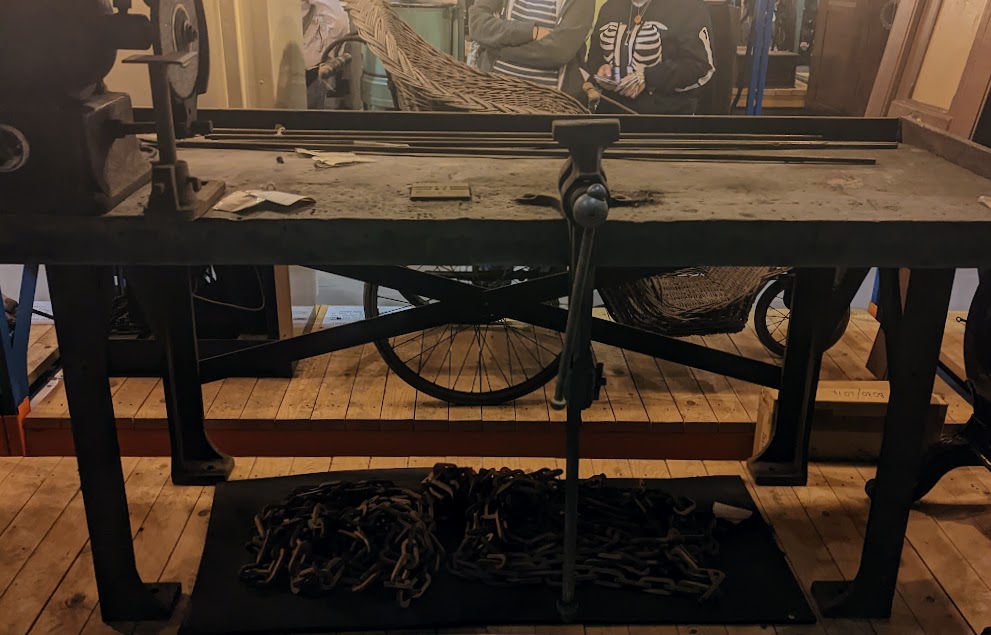
Leg Vice
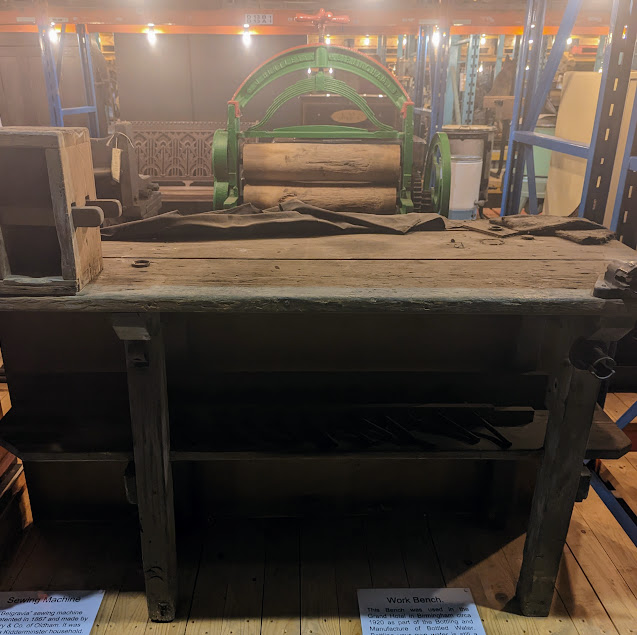
Work Bench
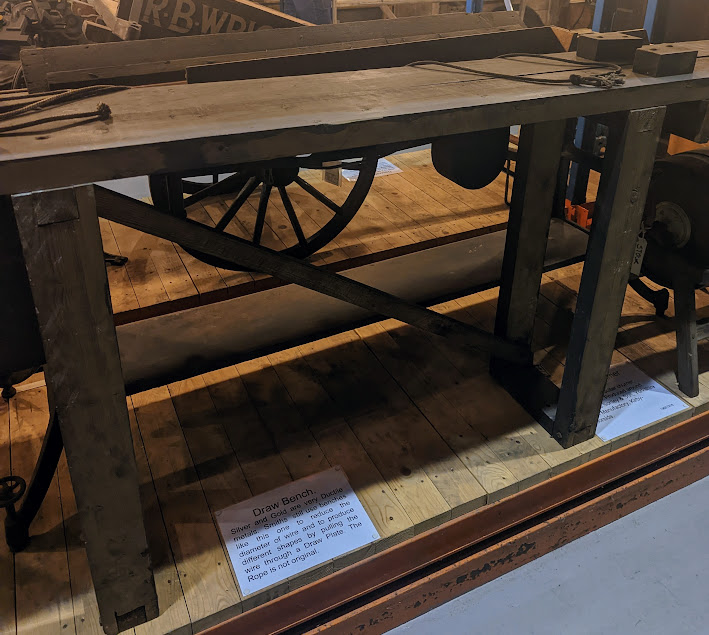
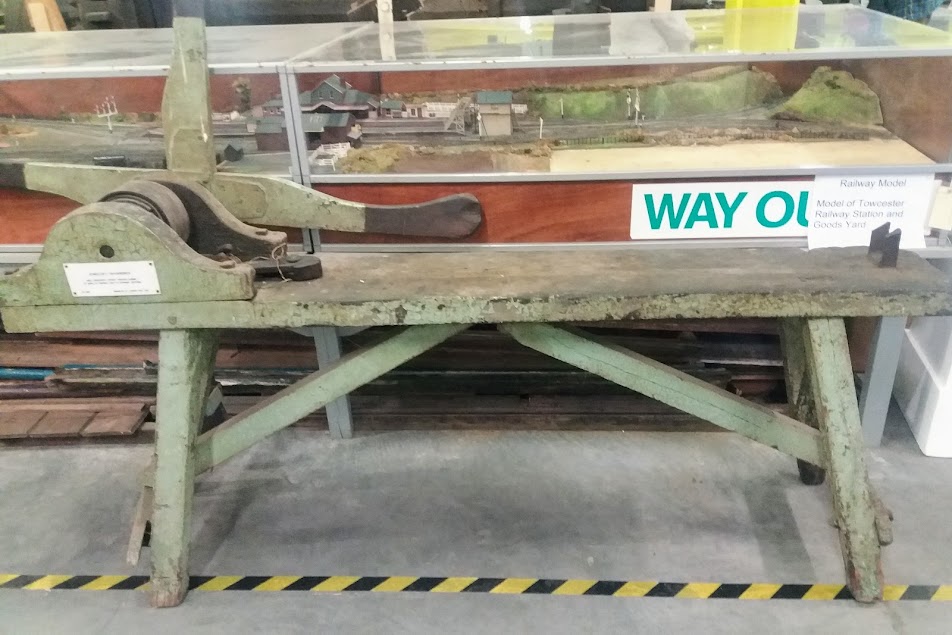
Draw Benches
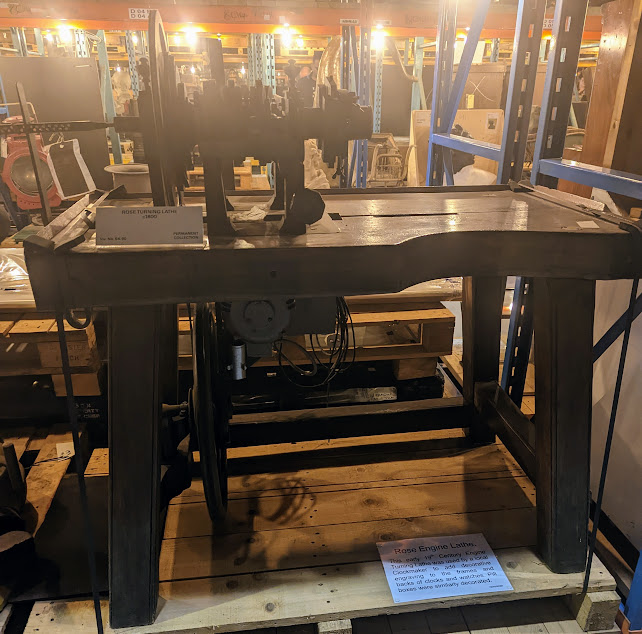
Rose Engine Lathe
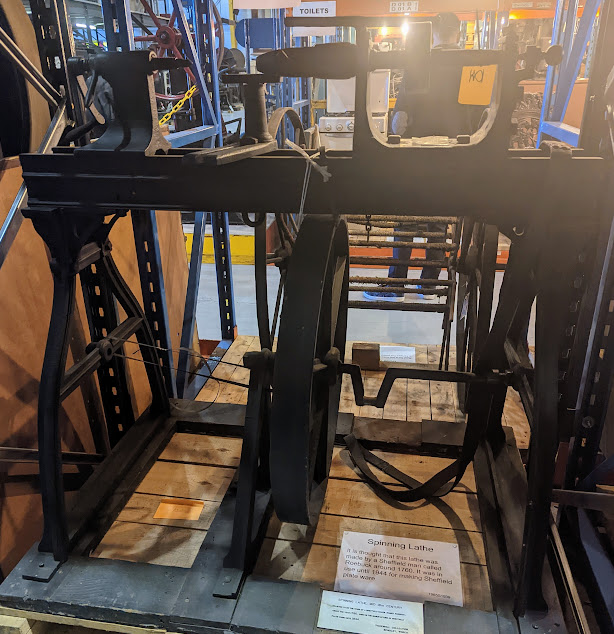
Spinning Lathe
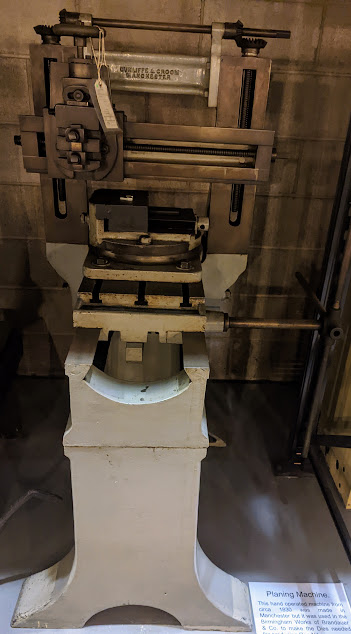
Planing Machine

Wheeling Machine
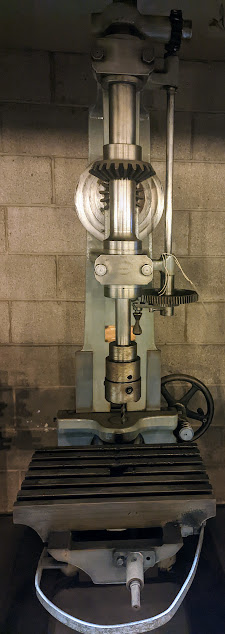
Drilling Machine
Local History: The Museum Collection Centre.
The Museum Collection: Photos – Page 1.
The Museum Collection: Photos – Page 2.
The Museum Collection: Photos – Page 3.
The Museum Collection: Photos – Page 4.
The Museum Collection: Photos – Page 5.
The Museum Collection: Photos – Page 6.
The Museum Collection: Photos – Page 7.
All the above images are copyright of Frank Parker.
Museum Collection Centre on Facebook.
Museum Collection Centre on Twitter.
Birmingham Museums Collection – Find out more about Birmingham’s collections including art and design, human history, natural science and science and industry categories. Each category contains sub-categories full of useful information and great photos.
Birmingham Museums Trust’s Digital Asset Resource – Official website. There is no registration or log-in required to use this website for out-of-copyright collection images Download free Public Domain image files up to 3mb in size with free Creative Commons licenses. You are entitled to unlimited downloads. Also download free Audio Files complete with a license. These can be downloaded for non-commercial use only and attribution is required.
BirminghamMAG – Official YouTube channel. Birmingham Museums and Art Gallery provide world-class museums at the cultural heart of Birmingham.
Birmingham Museums – Official website.
Thinktank: Birmingham Science Museum – Official website.
Birmingham Museum And Art Gallery – Official website.
Aston Hall – Official website.
Blakesley Hall – Official website.
Museum Of The Jewellery Quarter – Official website.
Sarehole Mill – Official website.
Soho House – Official website.
Weoly Castle – Official website.

Here are more photos I took on my first visit to the Museum Collection Centre on 17/09/22.
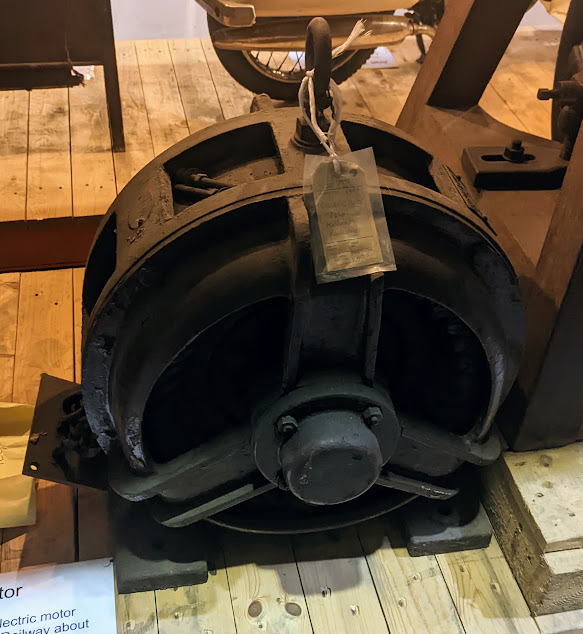
This 7.5 Horse Power electric motor was made by Midlands Railway in about 1890.

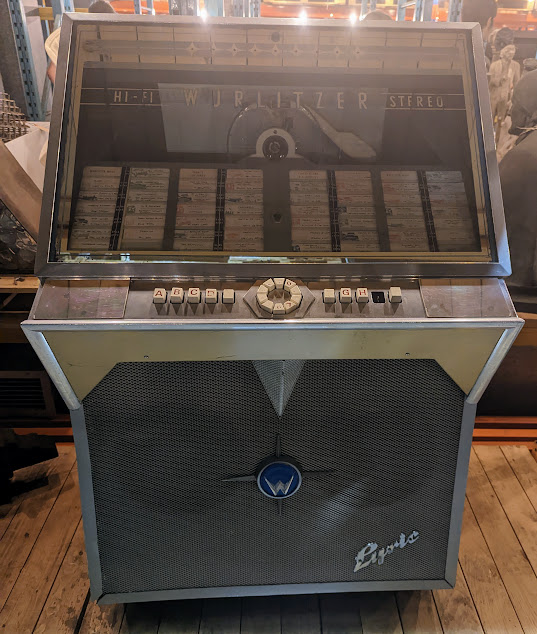
This music player was made in Germany circa 1961 by Wurlitzer, a well-known company whose name has become directly associated with the jukebox.

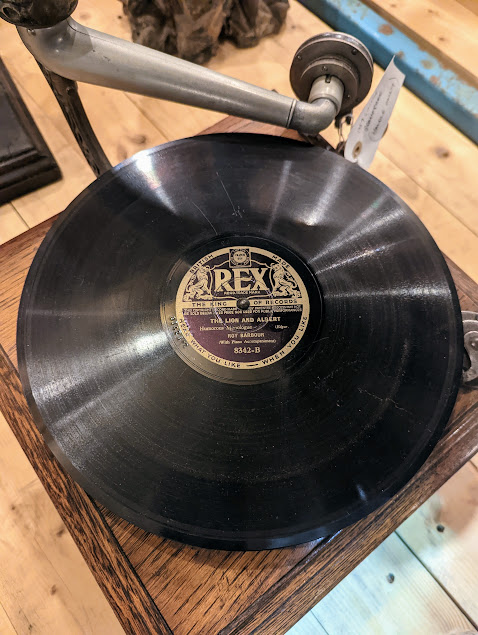
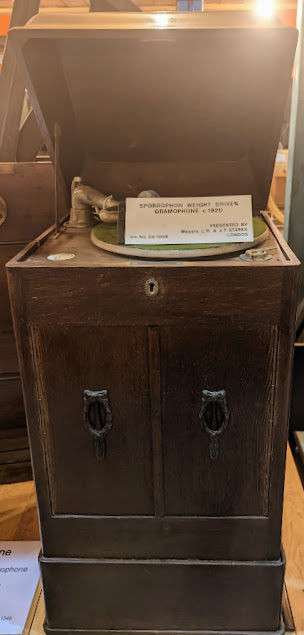
The turntable on this gramophone was driven by a weight mechanism. It was made by Sporrothon around 1920.
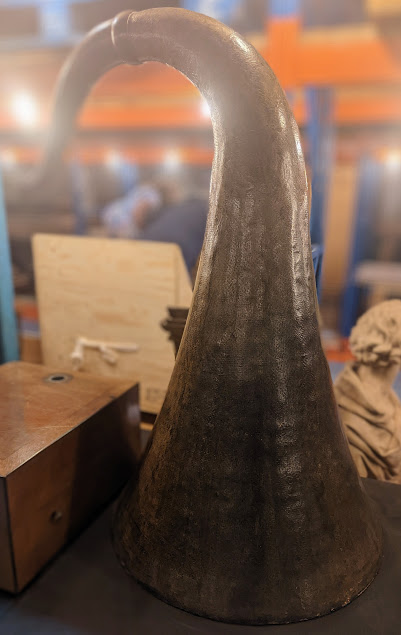
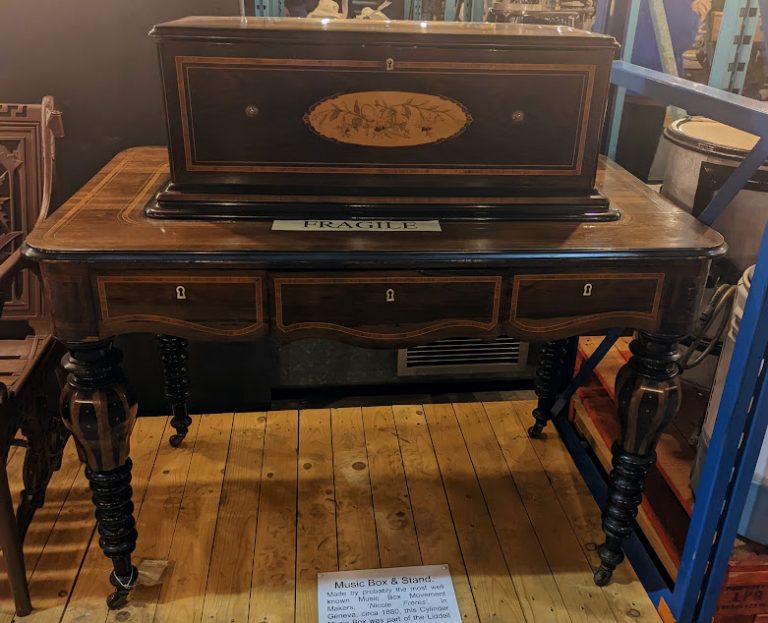
Made by probably the most well-known Music Box Movement Makers, Nicole Freres, in Geneva, circa 1880, this Cylinder Music Box was part of the Liddell Collection.
Read about the Music Box here.
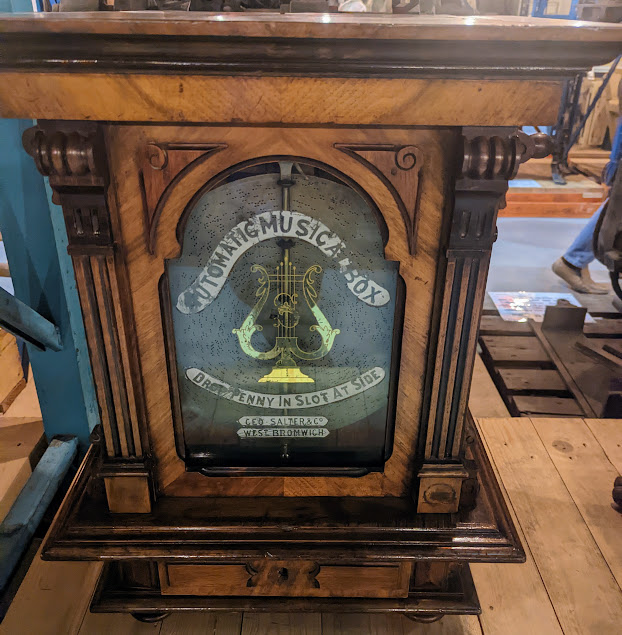
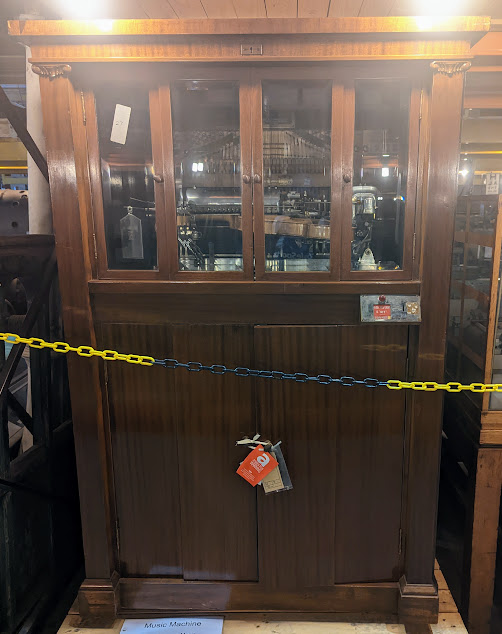
This Violano Virtuoso Music Machine was made by Mills Novelty Company, Chicago, USA. in the early 1950’s. It was electrically driven and had a combined mechanical piano and violin player.
Read about Mills Novelty Company here.
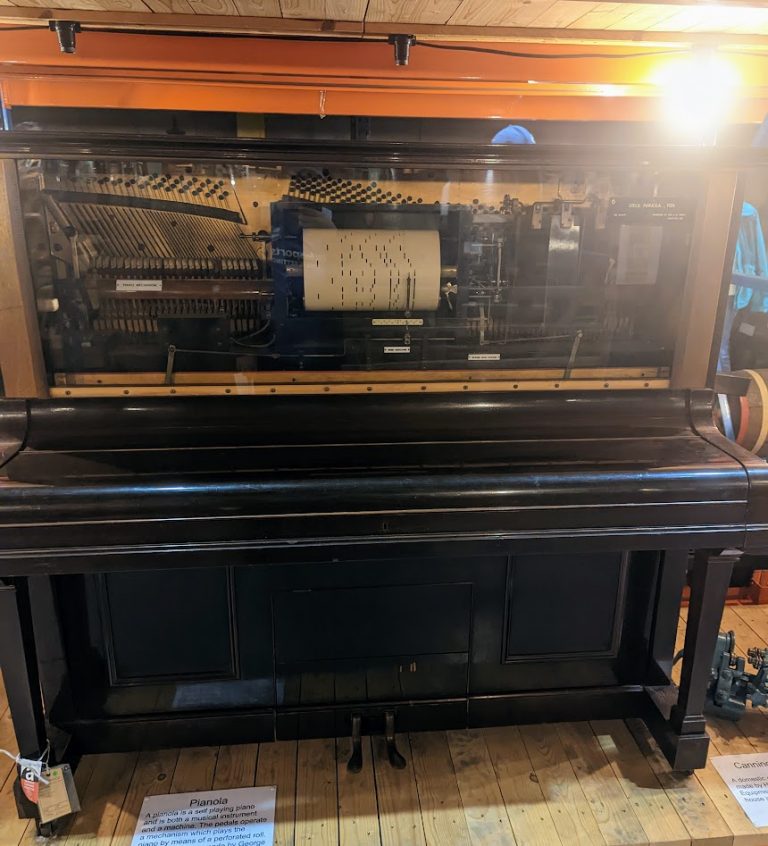
A player piano, also known as a pianola, is a self-playing piano and is both a musical instrument and a machine. The pedals operate a mechanism which plays the piano by means of a perforated roll. This example was made by George Steck & Company, USA in 1925.
Read about the Player Piano here.
Read about Steck here.
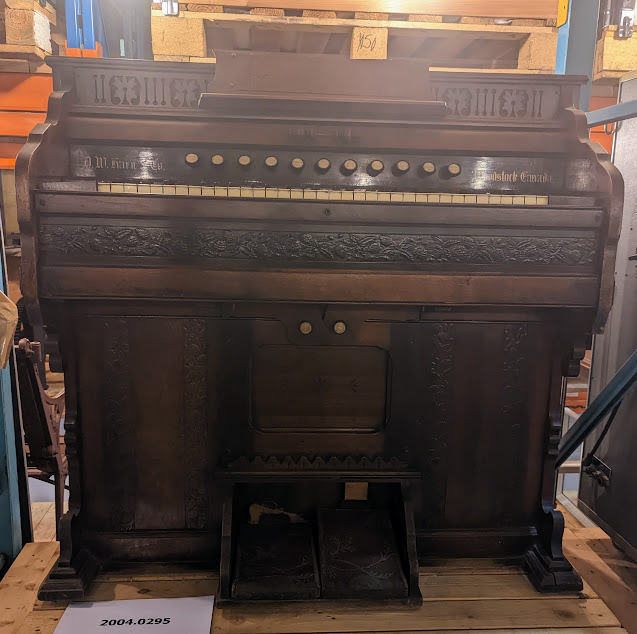
The pump organ, also known as a Harmonium, is a type of free-reed organ that generates sound as air flows past a vibrating piece of thin metal in a frame.
Read more about the pump organ here.

This Chamber Barrel Organ was made by T.C. Bates of Ludgate Hill, London in about 1830. It was once owned by a Clergyman but the tunes it played are not listed in the museum’s files.
Read about the Barrel Organ here.
This television and radio set is from the early 1950’s. Television sets were still quite rare in houses at this time, and this one may have been bought to watch Queen Elizabeth’s coronation in 1953.
Read about the Television Set here.
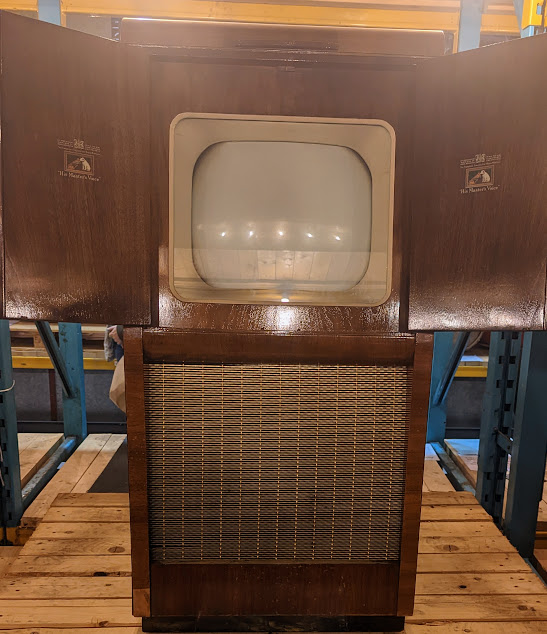
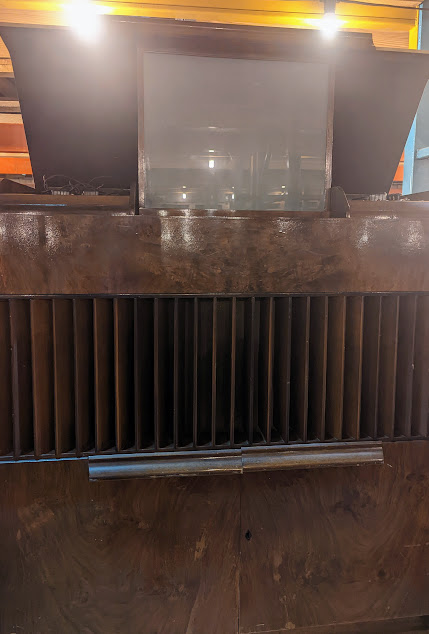
An early example of a projection television set which retailed at £325-0-0 in 1949. A Morris Minor car in the same year cost £349-0-0.
Read about Decca here.
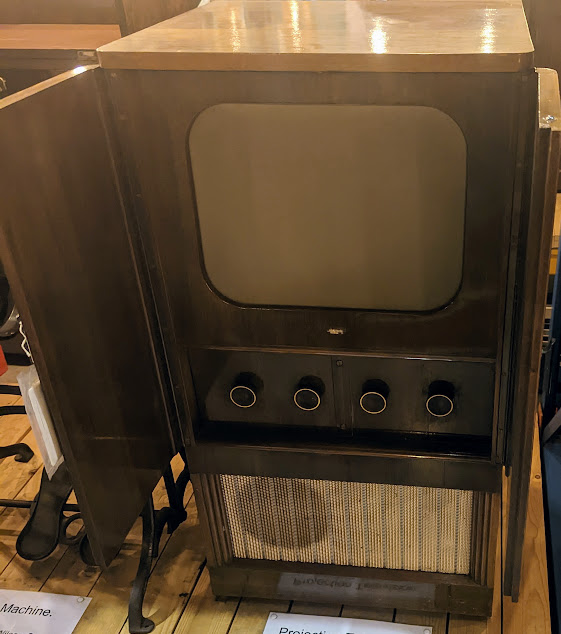
This Peto-Scott Television was introduced in 1950. it cost £71, 3 shillings and 4 pence when new, plus £16 Purchase Tax. Peto-Scott Electrical Instruments were based in Addlestone Road, Weybridge in Surrey.
Read about Peto-Scott Electrical Instruments here.
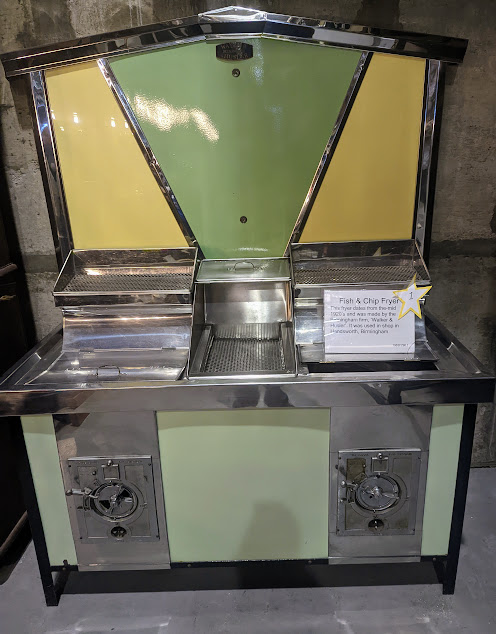
This fryer dates back to the mid 1920’s and was made by the Birmingham firm Walker & Husler. It was used in a shop in Handsworth, Birmingham.
Read about Fish and Chips here.
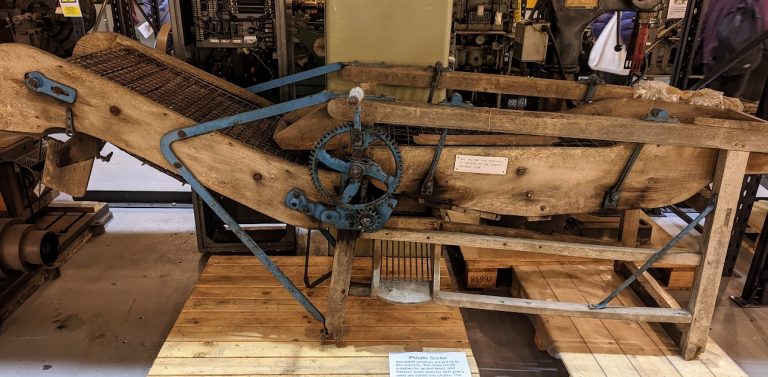
Harvested potatoes were put onto this machine. The chats (small potatoes for animal feed), and medium sized ones for the next years seed are sorted into chutes. The larger potatoes climb up the slope and fall into a sack at the end.
This is Berkel’s Model 2 slicing machine made by the Slicing Machine Manufacturing Company, Ponders End, Middlesex around 1950.
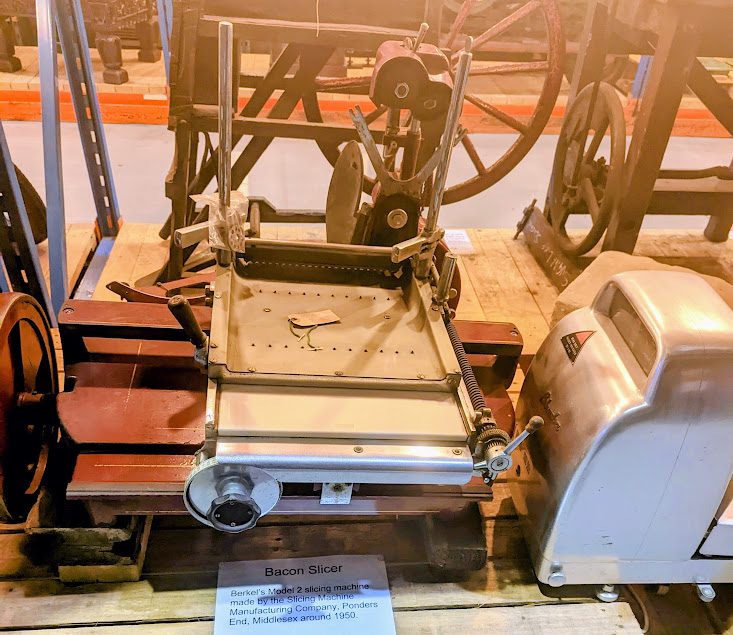
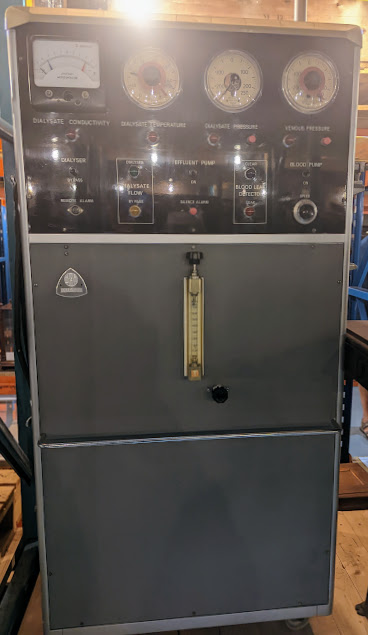
Local History: The Museum Collection Centre.
The Museum Collection: Photos – Page 1.
The Museum Collection: Photos – Page 2.
The Museum Collection: Photos – Page 3.
The Museum Collection: Photos – Page 4.
The Museum Collection: Photos – Page 5.
The Museum Collection: Photos – Page 7.
The Museum Collection: Photos – Page 8.
All the above images are copyright of Frank Parker.
Museum Collection Centre on Facebook.
Museum Collection Centre on Twitter.
Birmingham Museums Collection – Find out more about Birmingham’s collections including art and design, human history, natural science and science and industry categories. Each category contains sub-categories full of useful information and great photos.
Birmingham Museums Trust’s Digital Asset Resource – Official website. There is no registration or log-in required to use this website for out-of-copyright collection images Download free Public Domain image files up to 3mb in size with free Creative Commons licenses. You are entitled to unlimited downloads. Also download free Audio Files complete with a license. These can be downloaded for non-commercial use only and attribution is required.
BirminghamMAG – Official YouTube channel. Birmingham Museums and Art Gallery provide world-class museums at the cultural heart of Birmingham.
Birmingham Museums – Official website.
Thinktank: Birmingham Science Museum – Official website.
Birmingham Museum And Art Gallery – Official website.
Aston Hall – Official website.
Blakesley Hall – Official website.
Museum Of The Jewellery Quarter – Official website.
Sarehole Mill – Official website.
Soho House – Official website.
Weoly Castle – Official website.
Wikipedia – Official website. This is a free encyclopedia that anyone can edit.
Grace’s Guide – Official website. This is the leading source of historical information on industry and manufacturing in Britain. This web publication contains 149,969 pages of information and 235,611 images on early companies, their products and the people who designed and built them.
Here are more photos I took on my first visit to the Museum Collection Centre on 17/09/22.

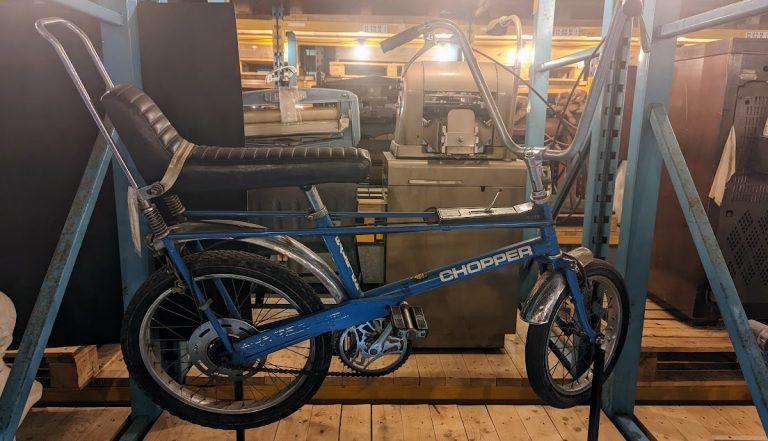
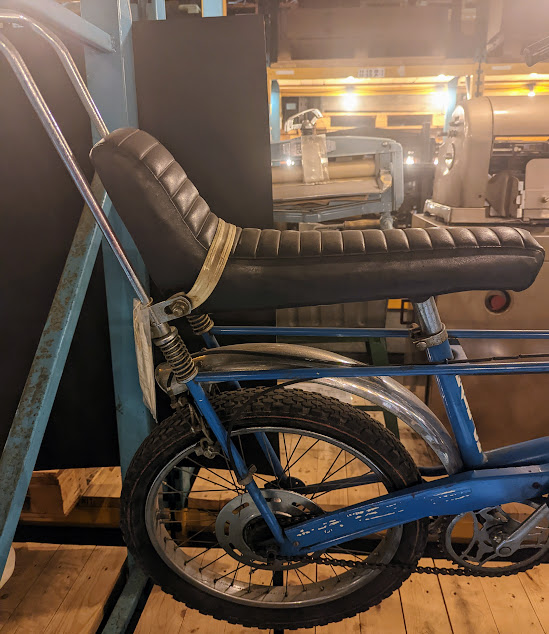
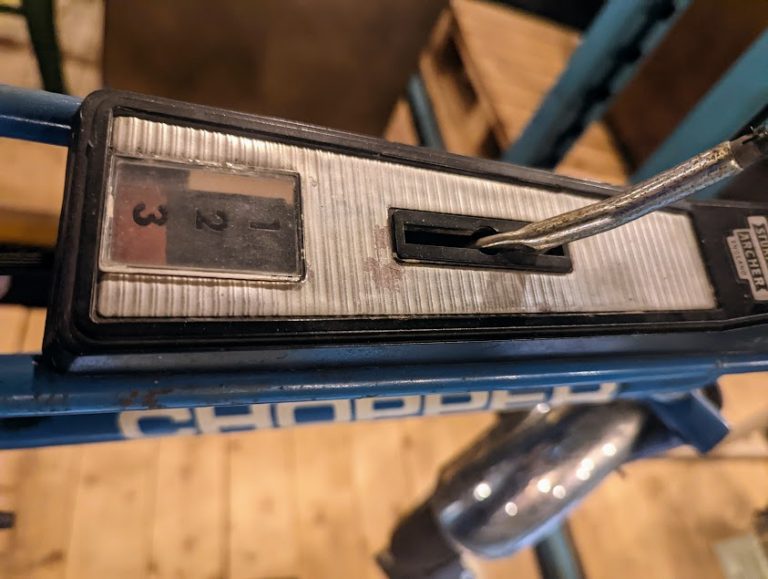
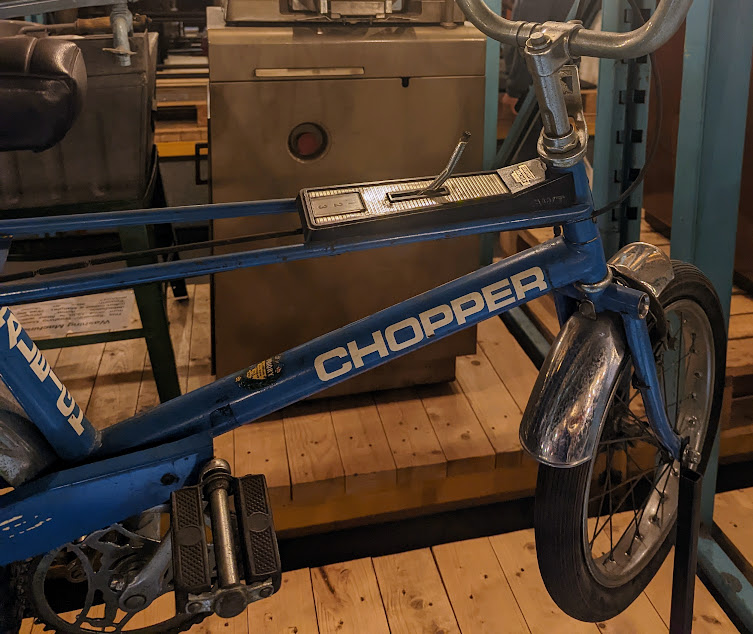
Chopper bikes are one of the icons of the 1970’s. This one (minus its red gear knob) was made by Raleigh, Nottingham and has three-speed Sturmey-Archer gears. It was bought second-hand in 1975 by a Stirchley man.
I used to have a friend who used to give me a backy on his red one of these but I always wanted the blue one shown here, of course. I had another friend whose Brother had a Raleigh Grifter I used to have a go on but it was no way near as COOL as the Chopper was.
Read about the Raleigh Chopper here.
Read about Raleigh here.
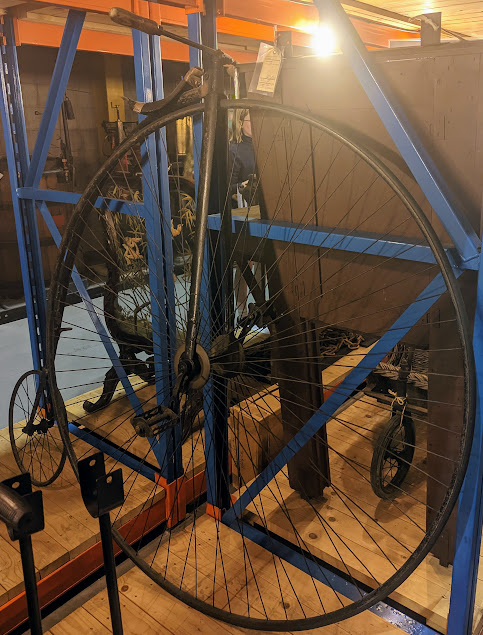
This bike was made by Carter of Stratford-On-Avon and was often called the Penny Farthing because of the size of its wheels.
I remember having a dream in the 1980’s about seeing a man on one of these. He was Victorian and had a top hat on. As he passed me he tipped his hat and waved at me!
Read about the ordinary bike here.
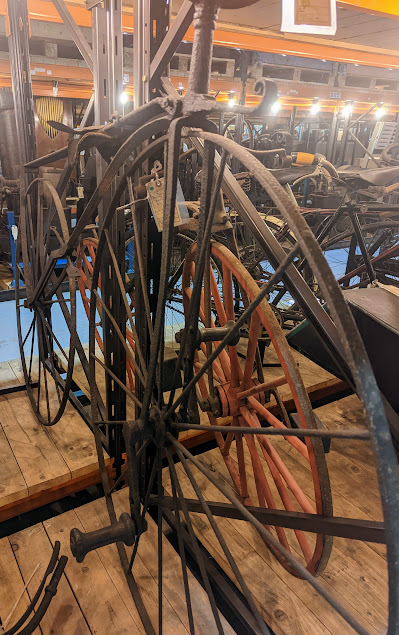
This Velocipede iron bike with wooden wheels is also known as the bone-shaker and was made by the French company Micheaux around 1870.
Read about the Velocipede here.
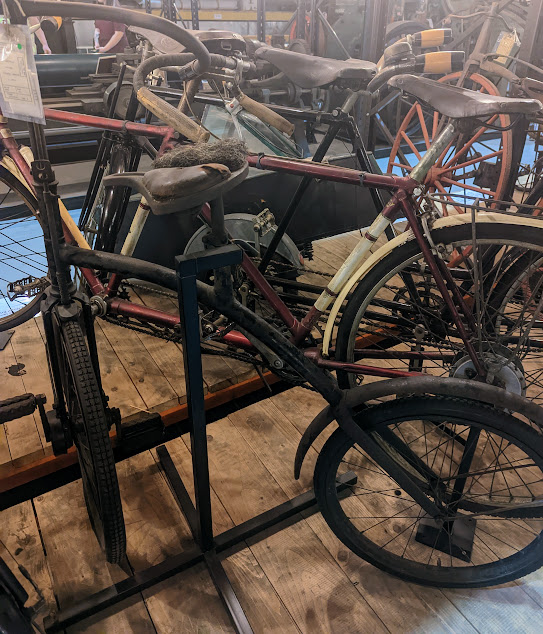
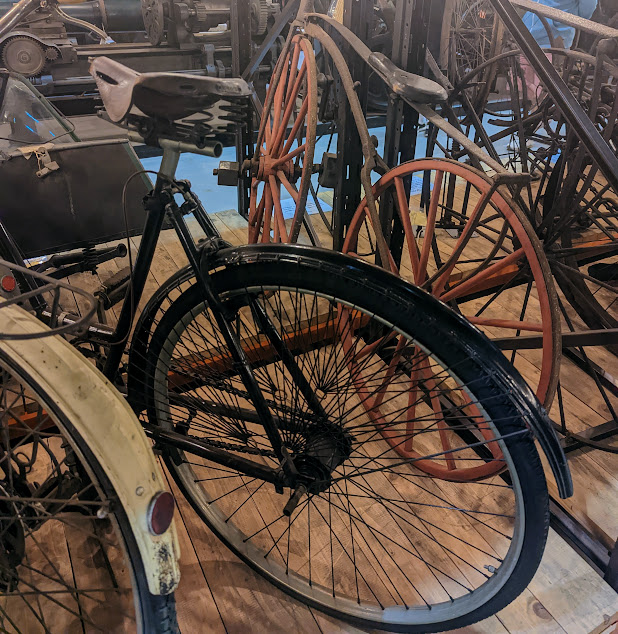
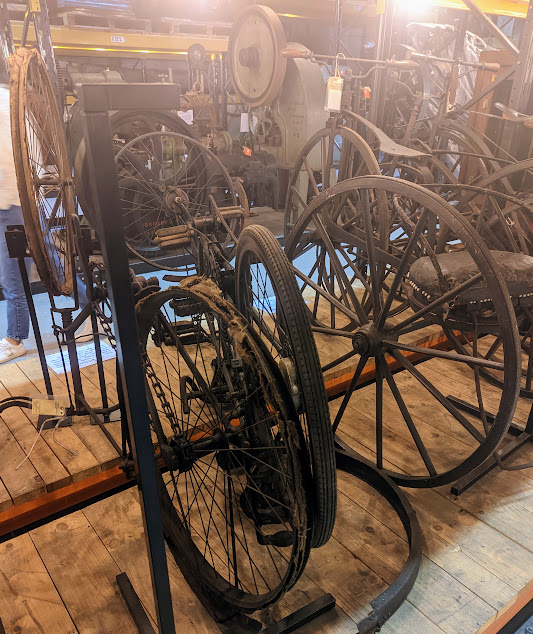
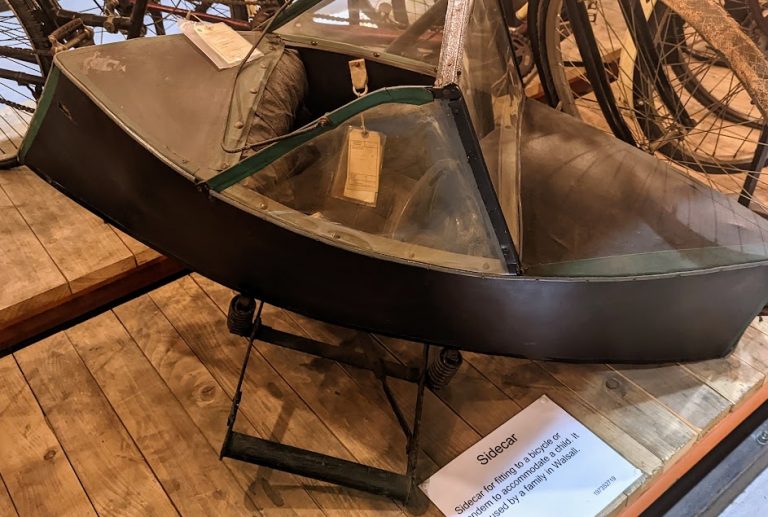
This is a sidecar for fitting to a bike or tandem to accommodate a child. It was used by a family in Walsall.
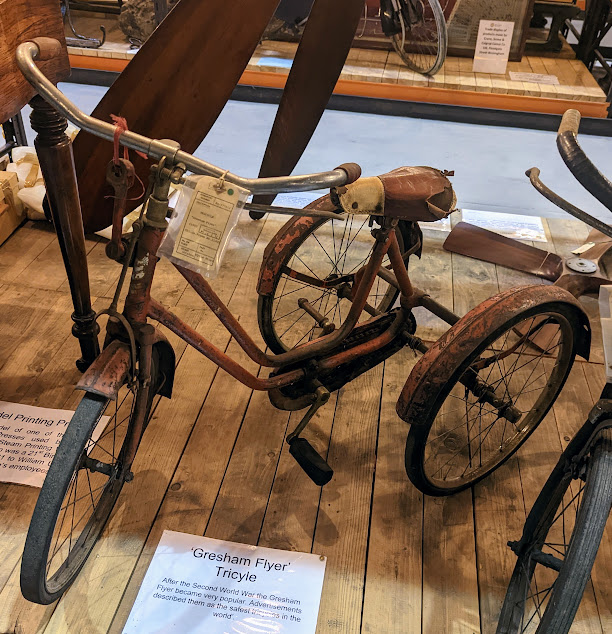
After the Second World War, the Gresham Flyer, made by the Aberdale Cycle Company, became very popular. Advertisements described them as the safest tricycles in the world.
Read about the Aberdale Cycle Company here.
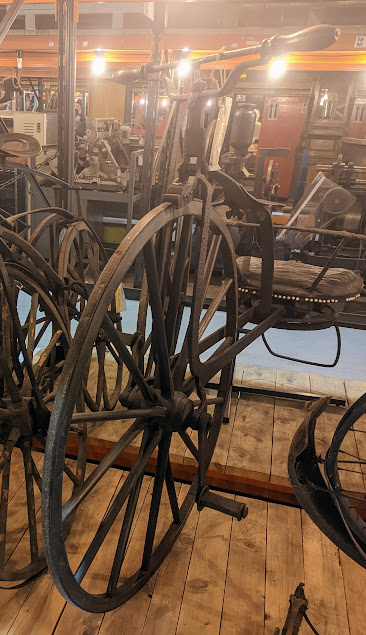
This two-seater Tricycle is circa 1860. The passenger faced backwards. Note the iron rims to the wheels, the direct drive and the Twist Grip brakes.
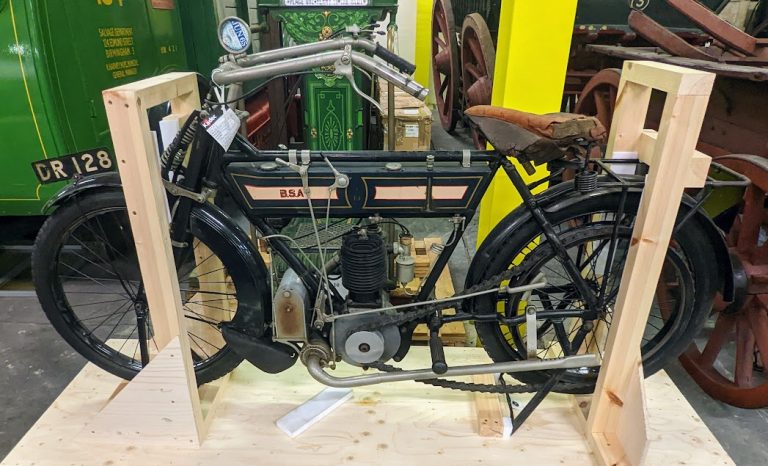
This bike is circa 1920 and was made by the B.S.A. Company. They purchased the rights to the B.S.A. name from Birmingham Small Arms Company.
Read about the B.S.A. Company here.
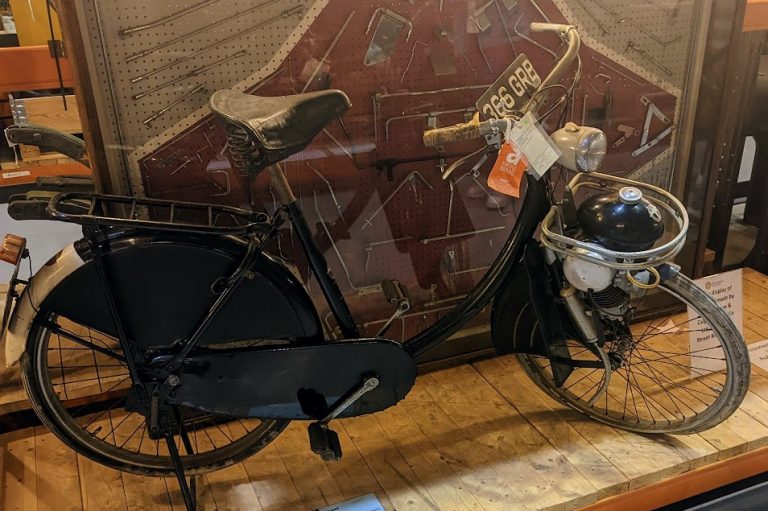
This is a Pulvier Moped made by the Berini Company in Italy in 1958.
Read about the Berini Company here.
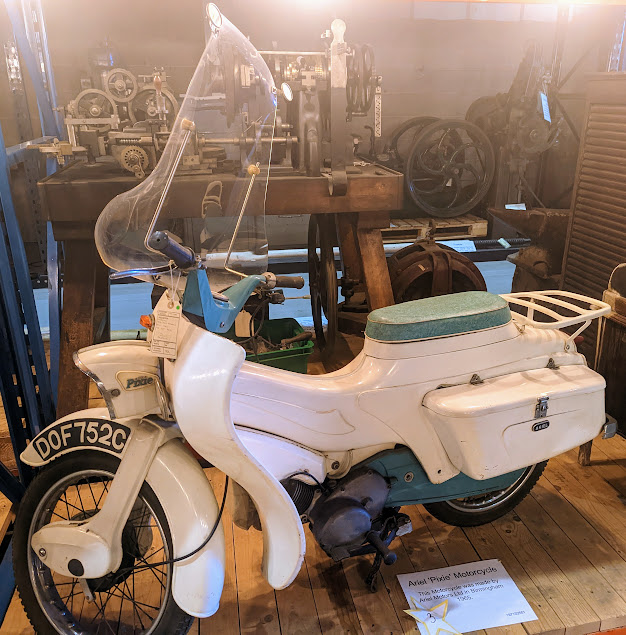
This scooter was made in 1965 by Ariel Motorcycles in Bournbrooke, Birmingham.
Read about Ariel Motorcycles here.
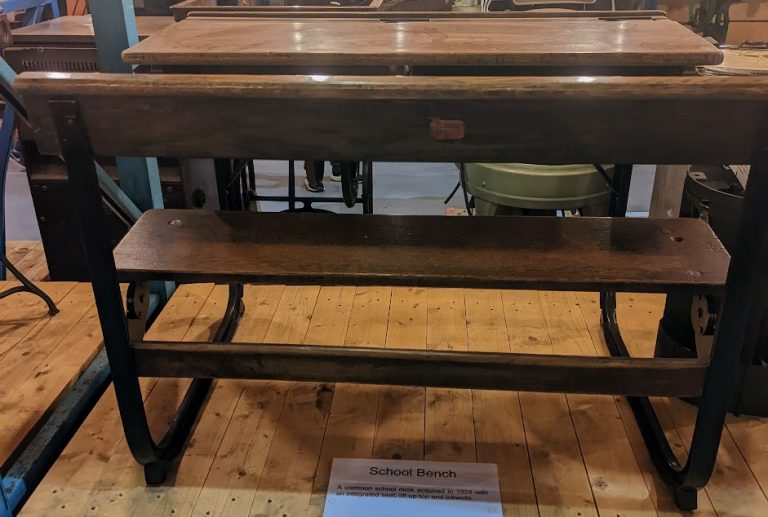
This common school desk was acquired in 1954 with an integrated seat, lift-up top and inkwells.
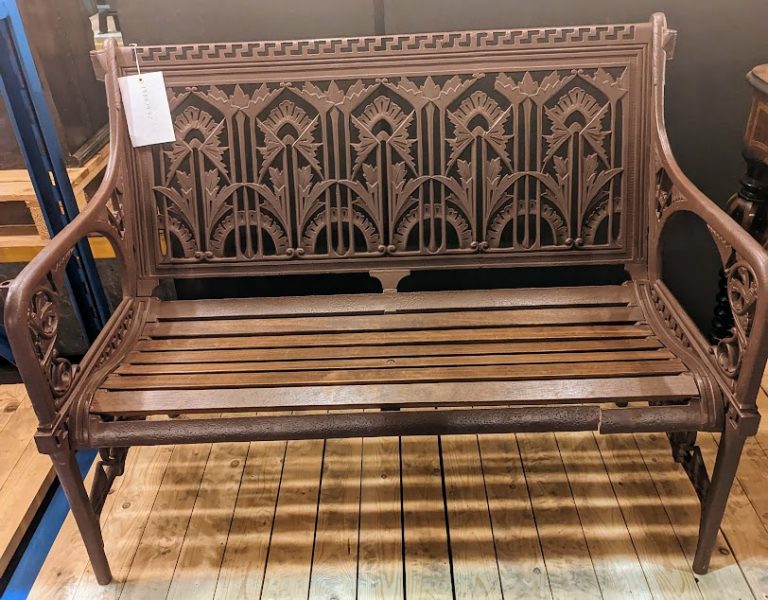
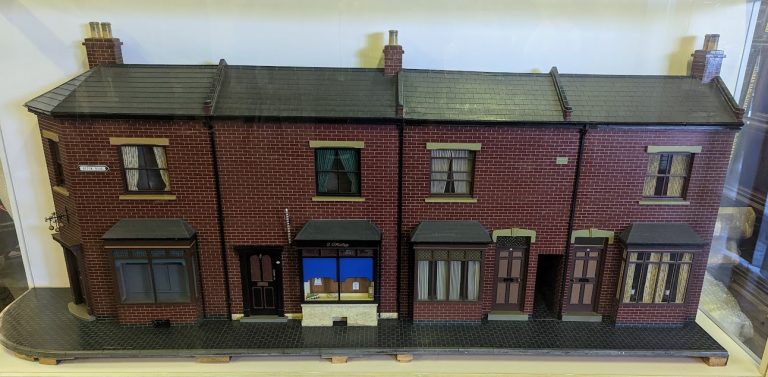
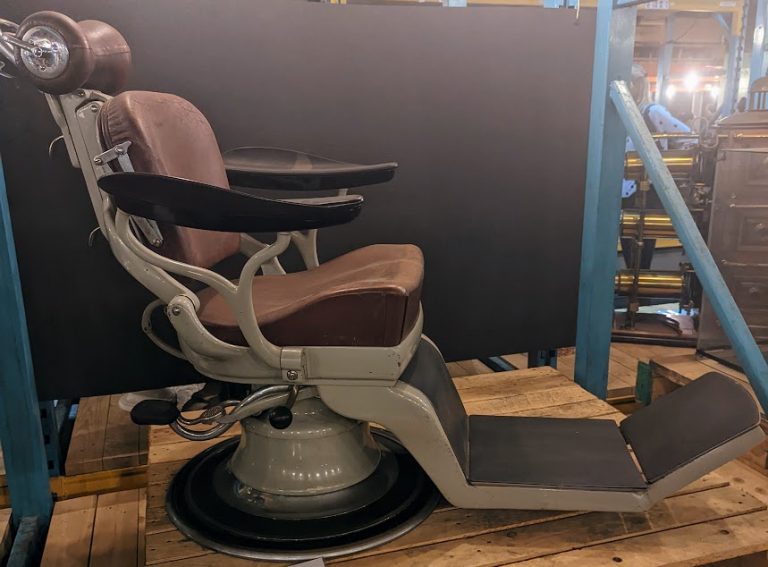
This Dentist’s chair may have been associated with a dental X-ray machine also held in the Museum Collection Centre but they have no details on record.

This bath-tub coffin was excavated by Leonard Woolley at the site of the Ur in southern Iraq. The body was laid in a foetal position. This example dates from about 500 BC.
Read about Woolley here.
Local History: The Museum Collection Centre.
The Museum Collection: Photos – Page 1.
The Museum Collection: Photos – Page 2.
The Museum Collection: Photos – Page 3.
The Museum Collection: Photos – Page 5.
The Museum Collection: Photos – Page 6.
The Museum Collection: Photos – Page 7.
The Museum Collection: Photos – Page 8.
All the above images are copyright of Frank Parker.
Museum Collection Centre on Facebook.
Museum Collection Centre on Twitter.
Birmingham Museums Collection – Find out more about Birmingham’s collections including art and design, human history, natural science and science and industry categories. Each category contains sub-categories full of useful information and great photos.
Birmingham Museums Trust’s Digital Asset Resource – Official website. There is no registration or log-in required to use this website for out-of-copyright collection images Download free Public Domain image files up to 3mb in size with free Creative Commons licenses. You are entitled to unlimited downloads. Also download free Audio Files complete with a license. These can be downloaded for non-commercial use only and attribution is required.
BirminghamMAG – Official YouTube channel. Birmingham Museums and Art Gallery provide world-class museums at the cultural heart of Birmingham.
Birmingham Museums – Official website.
Thinktank: Birmingham Science Museum – Official website.
Birmingham Museum And Art Gallery – Official website.
Aston Hall – Official website.
Blakesley Hall – Official website.
Museum Of The Jewellery Quarter – Official website.
Sarehole Mill – Official website.
Soho House – Official website.
Weoly Castle – Official website.
Wikipedia – Official website. This is a free encyclopedia that anyone can edit.
Sheldon’s EMU – Official website. This website began as a collection of articles, letters and emails about European motorcycles, the result of research and correspondence dating back to 1994. It now covers several thousand different marques, many of which have extensive archives including images and specifications. The site relates to vintage, veteran and classic motorcycles, scooters and mopeds, with numerous pages on road-racing and off-road competition machines. There is a wealth of information for motorcycle enthusiasts, restorers and historians, and the site continues to amass data at a steady pace.

Here are more photos I took on my first visit to the Museum Collection Centre on 17/09/22.
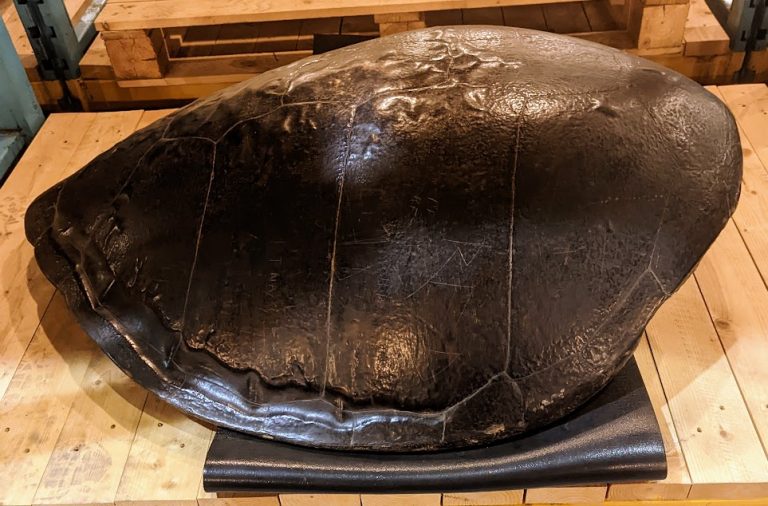
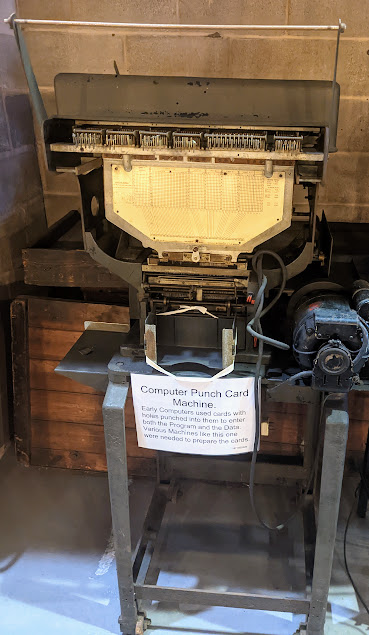
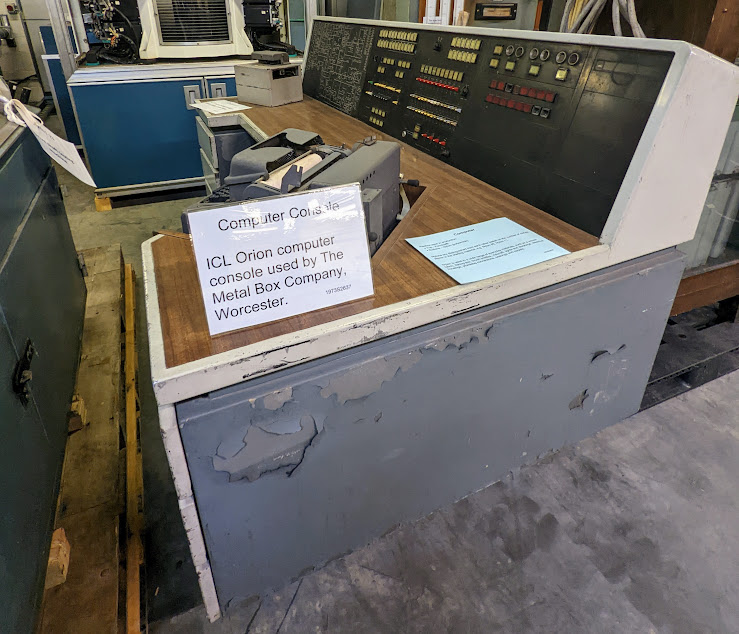
The ICL Orion computer console used by the Metal Box Company, Worcester.
Read about the Orion here.
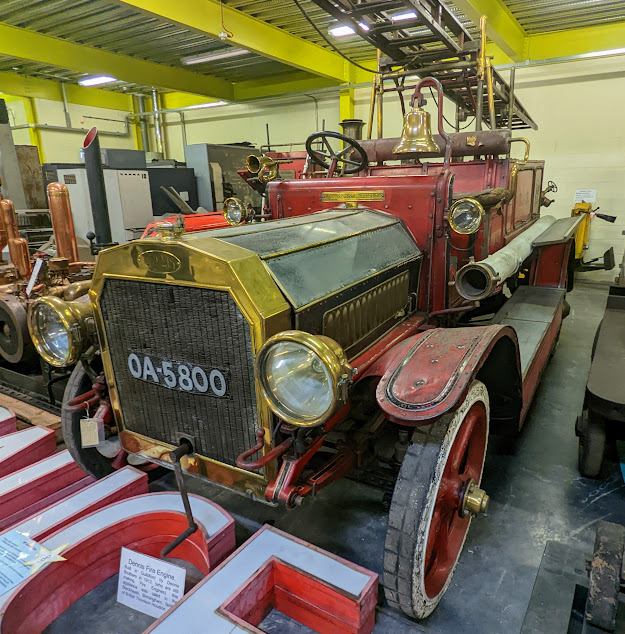
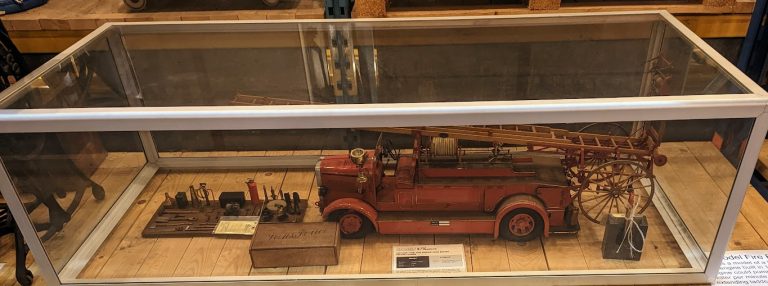
This is a model of a Leyland Cub fire engine built in 1936. The real engine could pump 700 gallons of water per minute and had a 50-foot extending ladder.
Read about Leyland Motors here.
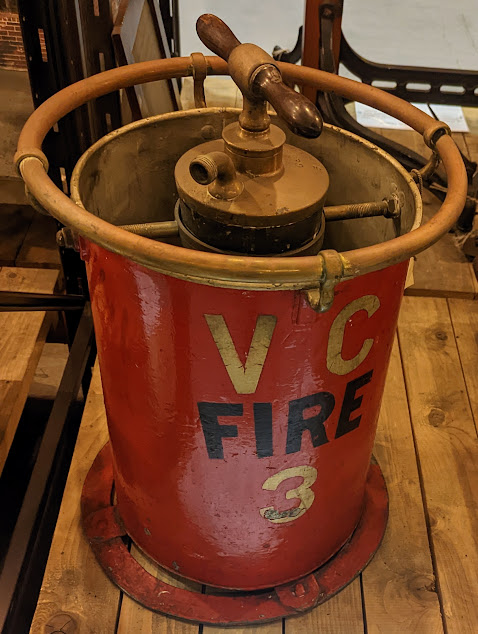
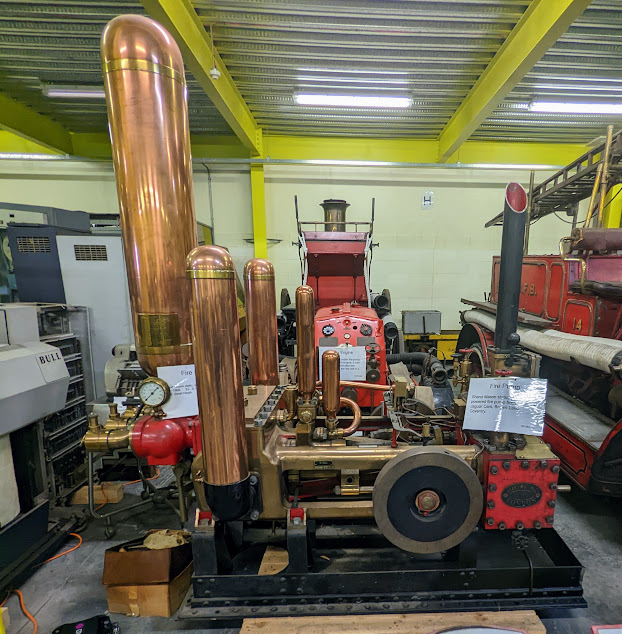
Read about fire pumps here.
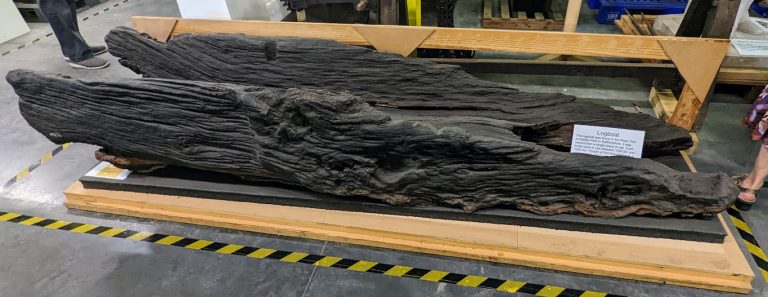
This logboat (also known as a dugout canoe) was found in the River Tern at Oakley Park in Staffordshire. It was carved from a single piece of oak. Such boats were in use between 1600 BC and 1000 AD. People at first thought it was a water trough and this can not be ruled out but the deliberately made holes in the sides suggest a boat is more likely.
Read about logboats here.
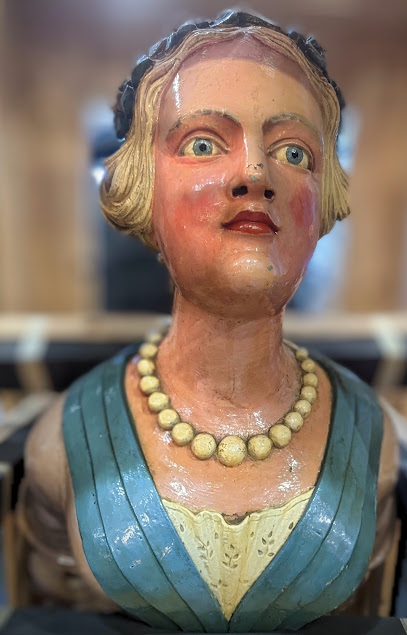
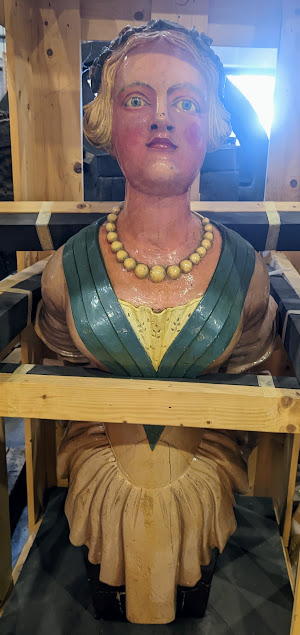
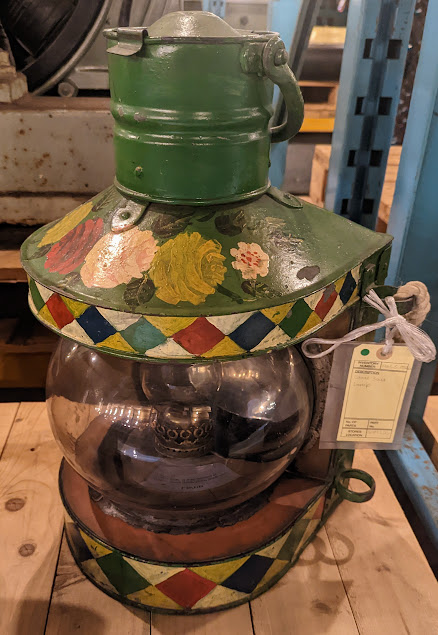
This domed head mast-head lamp is from a canal boat and was painted by Thomas William King.
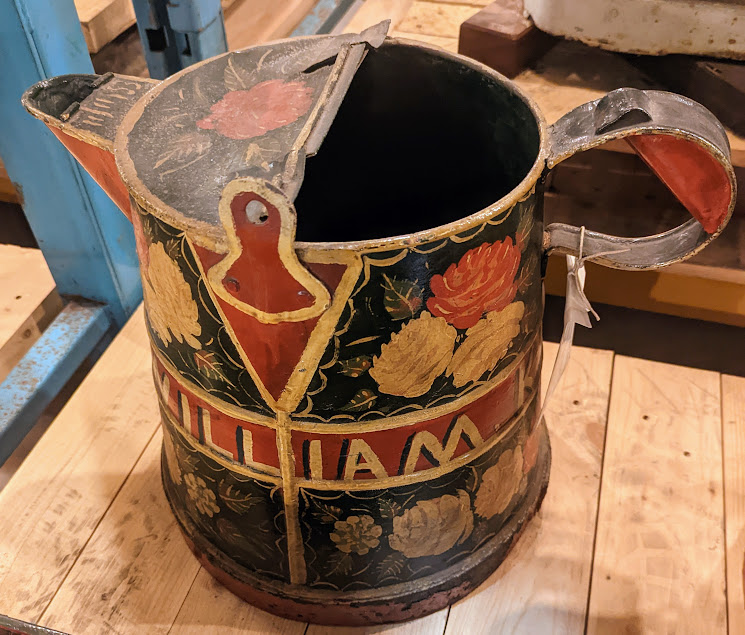
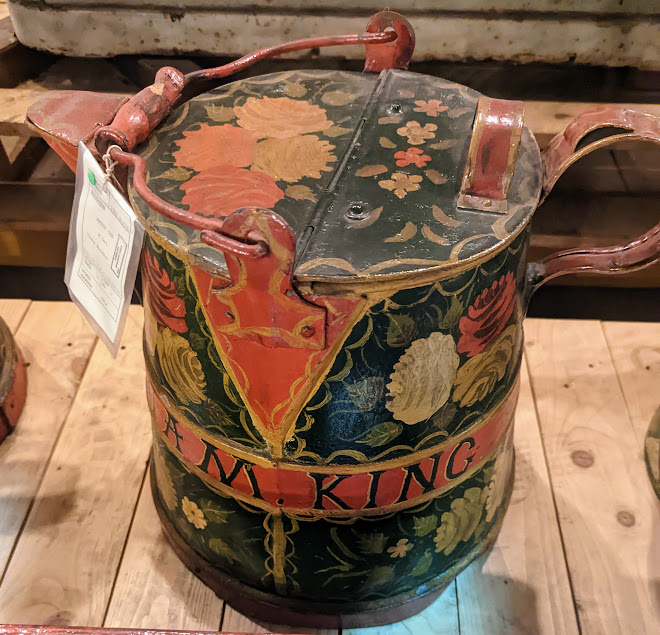
A pair of large metal jugs from a canal boat painted by Thomas William King, circa 1955.
Read about Thomas William King here.

Read about Narrowboats here.
Click here to read about The Allcotts (my family on my Mom’s side) who have had a history with canal boats for over 200 years.
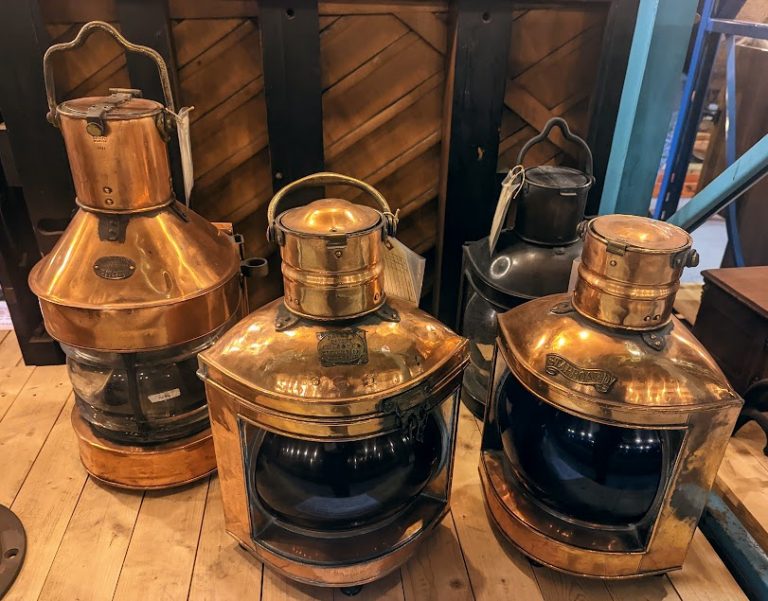
These three copper lamps (port, mast-head and starboard) are from the paddle steamer Lucy Ashton and a steaming light, made in Birmingham.
Read about paddle steamer Lucy Ashton here.
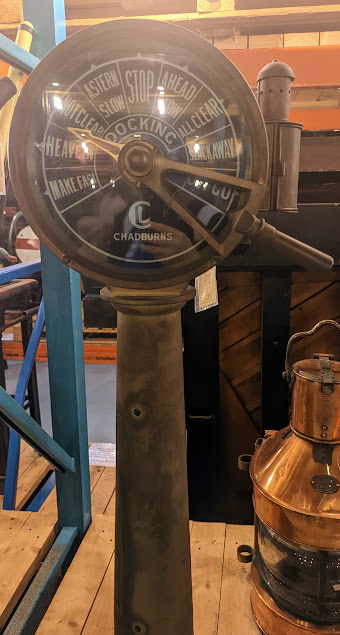
This is used to send instructions to the engine room.
Read about the engine order telegraph here.
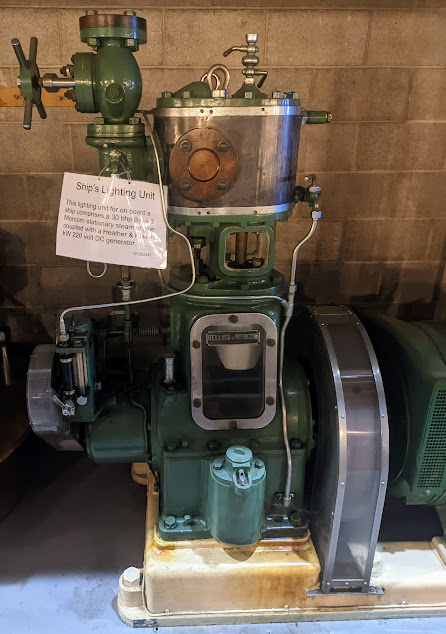
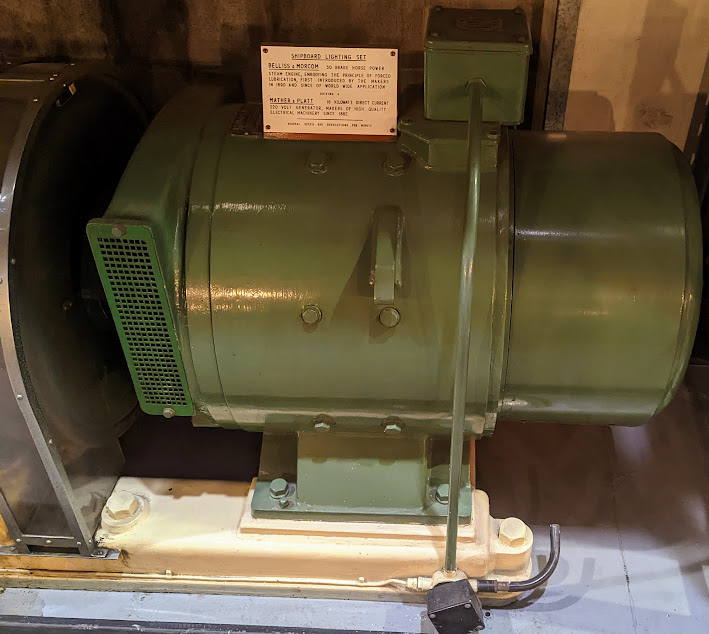
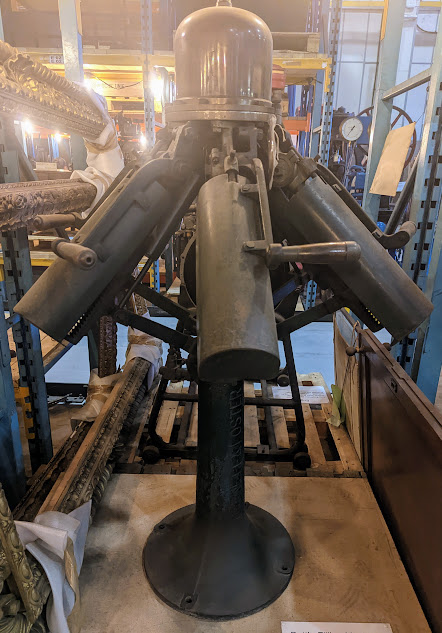
This Barnett and Foster machine was used in 1910 to prepare bottles of Mineral Water for use in the Grand Hotel in Birmingham. Bottling your own water is still a common practice today.
Read about Barnett and Foster here.
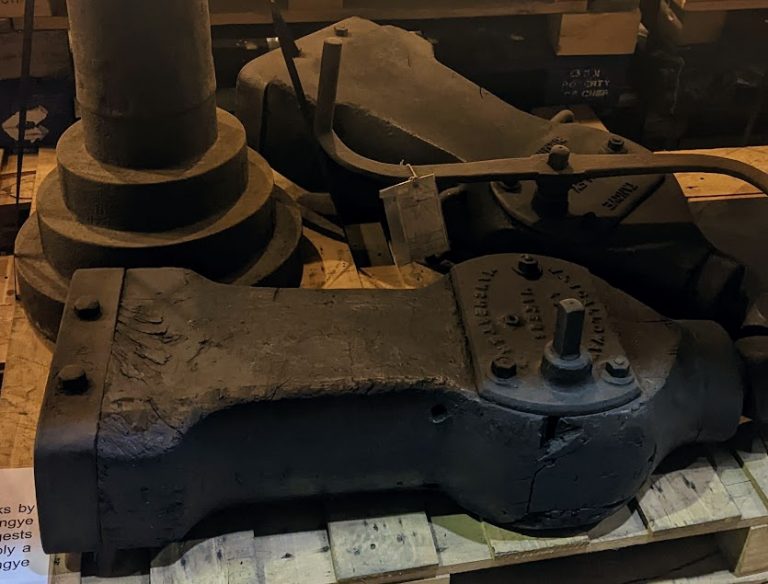
Local History: The Museum Collection Centre.
The Museum Collection: Photos – Page 1.
The Museum Collection: Photos – Page 2.
The Museum Collection: Photos – Page 4.
The Museum Collection: Photos – Page 5.
The Museum Collection: Photos – Page 6.
The Museum Collection: Photos – Page 7.
The Museum Collection: Photos – Page 8.
All the above images are copyright of Frank Parker.
Museum Collection Centre on Facebook.
Museum Collection Centre on Twitter.
Birmingham Museums Collection – Find out more about Birmingham’s collections including art and design, human history, natural science and science and industry categories. Each category contains sub-categories full of useful information and great photos.
Birmingham Museums Trust’s Digital Asset Resource – Official website. There is no registration or log-in required to use this website for out-of-copyright collection images Download free Public Domain image files up to 3mb in size with free Creative Commons licenses. You are entitled to unlimited downloads. Also download free Audio Files complete with a license. These can be downloaded for non-commercial use only and attribution is required.
BirminghamMAG – Official YouTube channel. Birmingham Museums and Art Gallery provide world-class museums at the cultural heart of Birmingham.
Birmingham Museums – Official website.
Thinktank: Birmingham Science Museum – Official website.
Birmingham Museum And Art Gallery – Official website.
Aston Hall – Official website.
Blakesley Hall – Official website.
Museum Of The Jewellery Quarter – Official website.
Sarehole Mill – Official website.
Soho House – Official website.
Weoly Castle – Official website.
Wikipedia – Official website. This is a free encyclopedia that anyone can edit.
Made In Oldbury – Official Website. This website explores unique archive materials in Sandwell in relation to local industrial heritage.
Grace’s Guide – Official website. This is the leading source of historical information on industry and manufacturing in Britain. This web publication contains 149,969 pages of information and 235,611 images on early companies, their products and the people who designed and built them.